
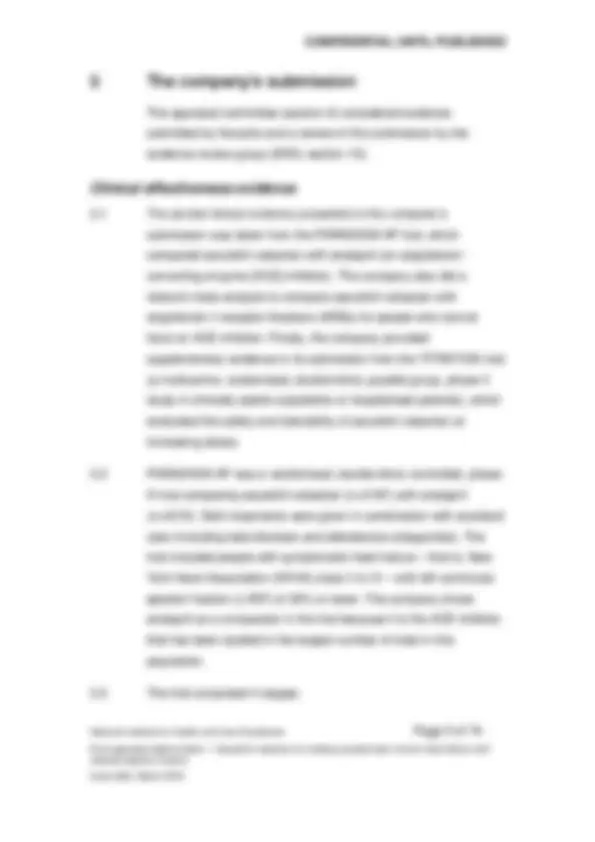
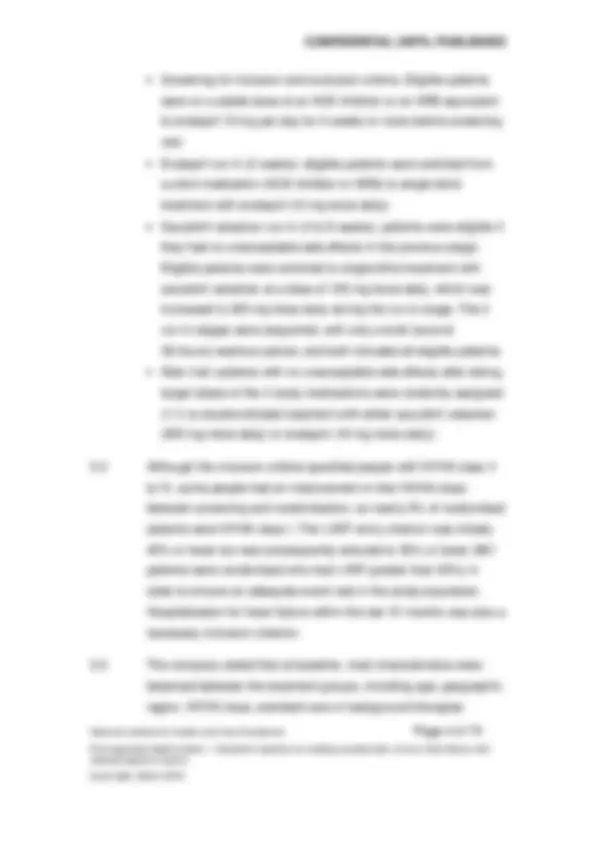
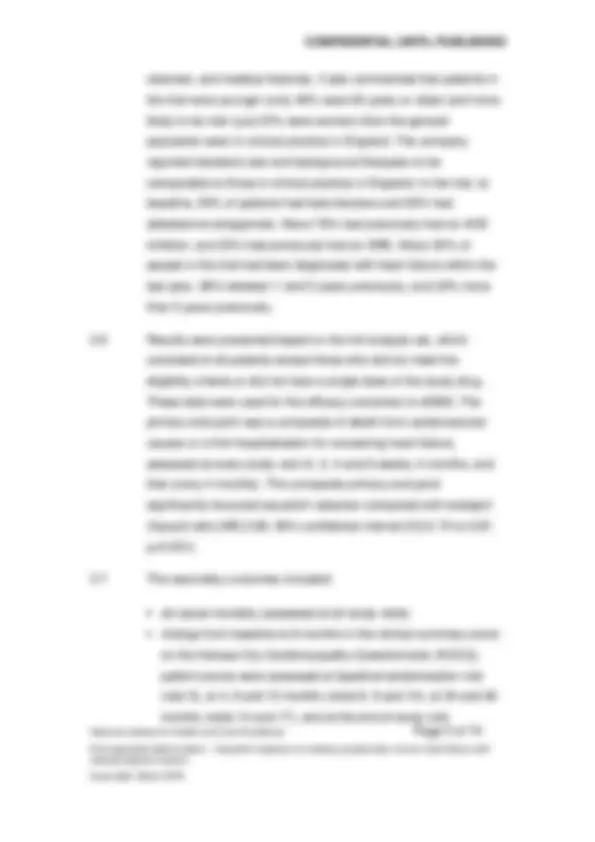
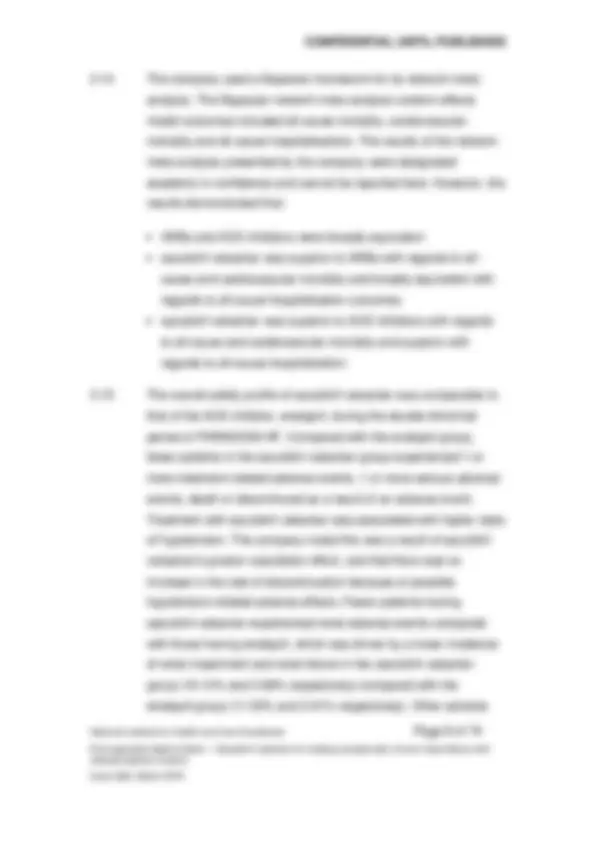
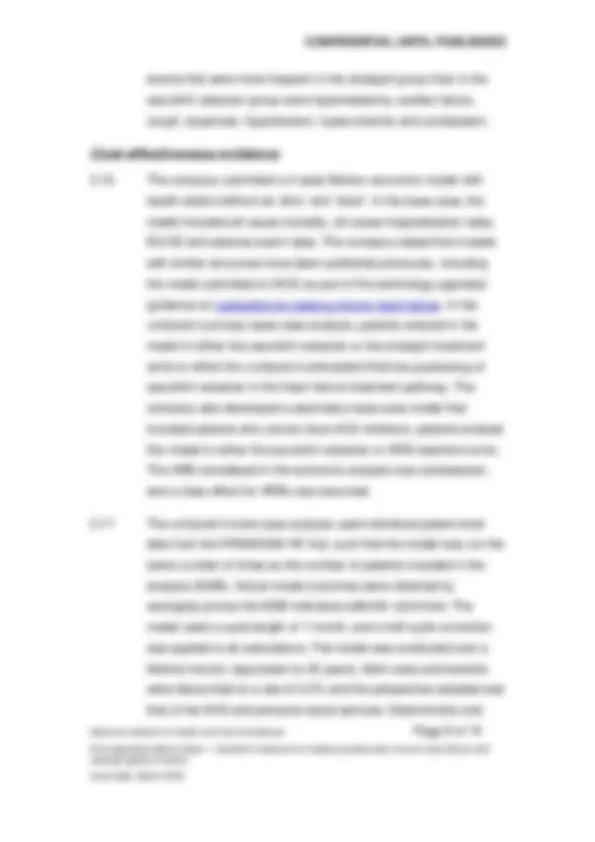
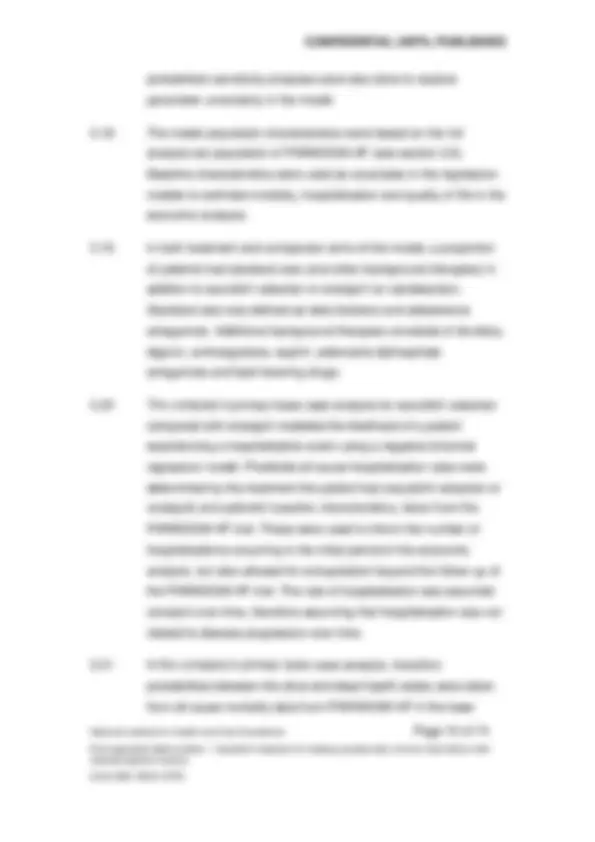
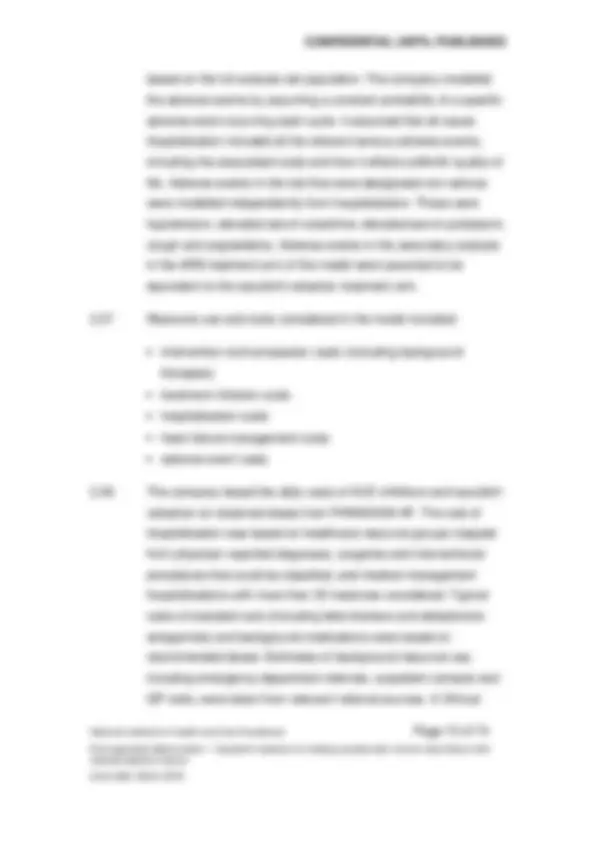
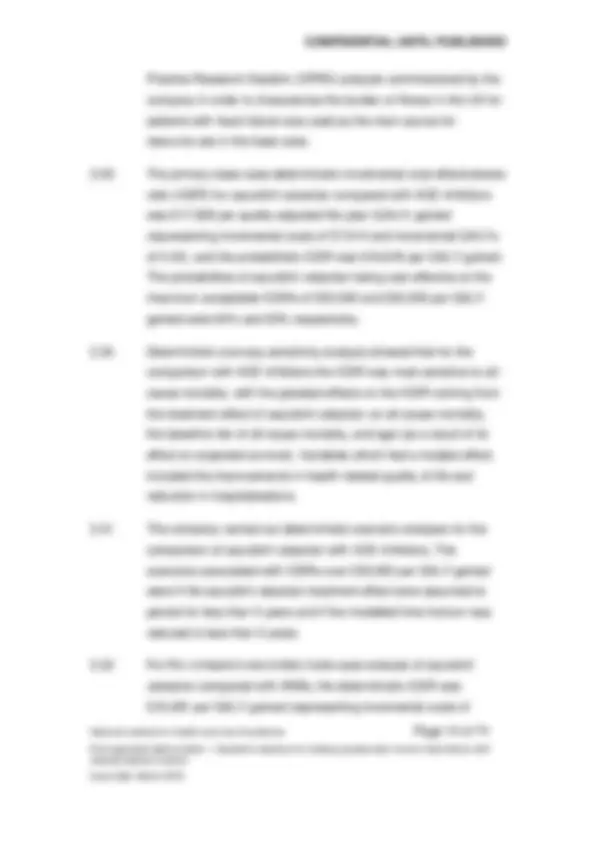
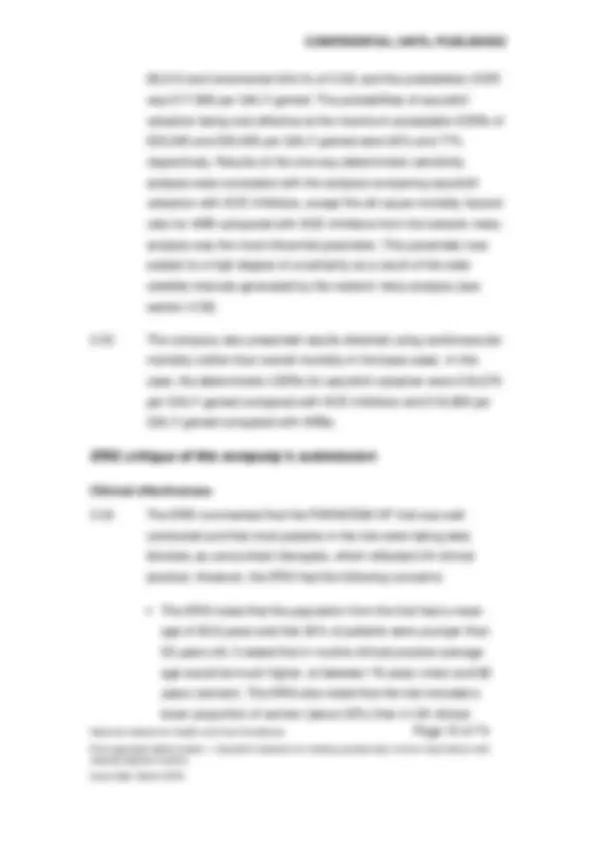
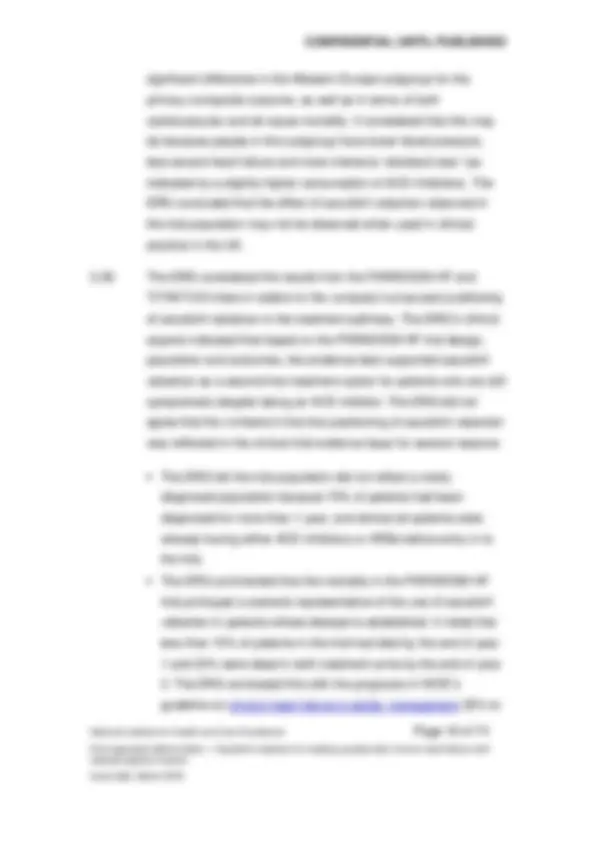
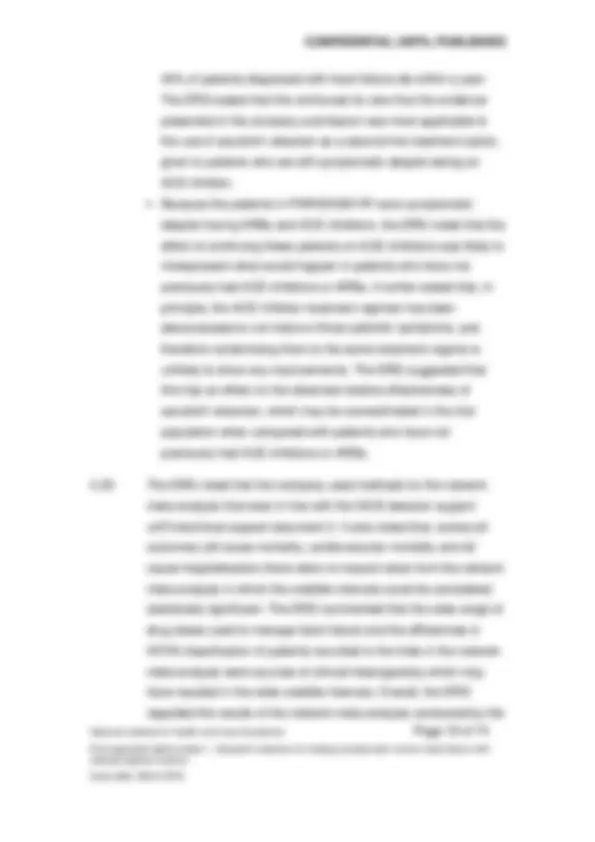
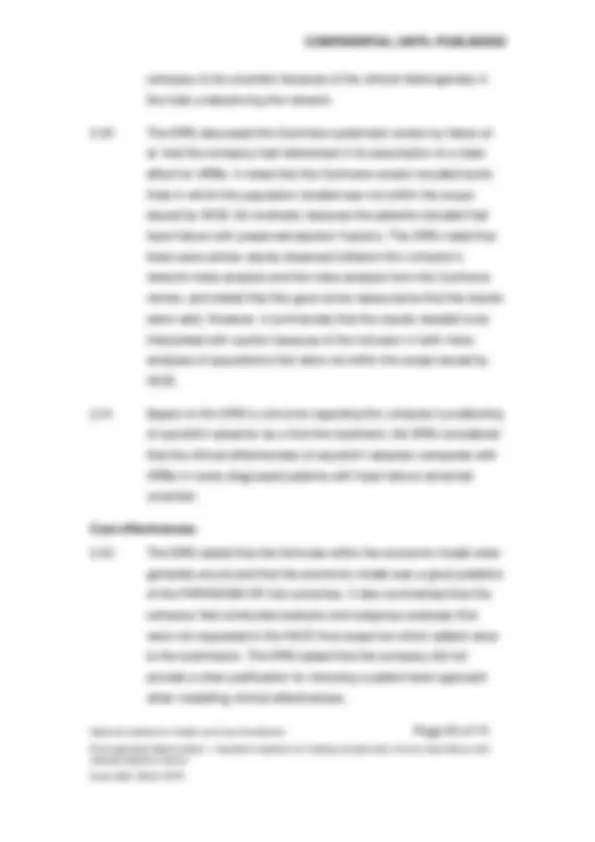
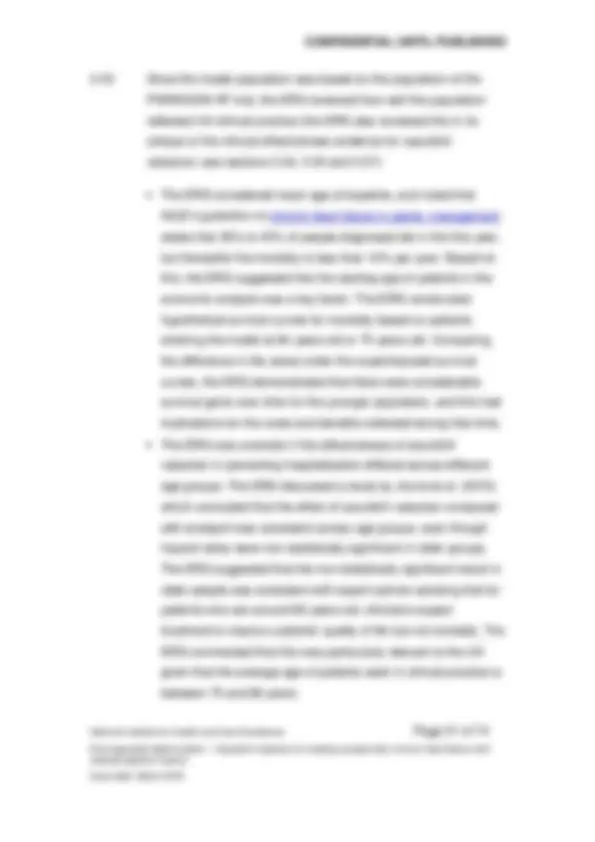
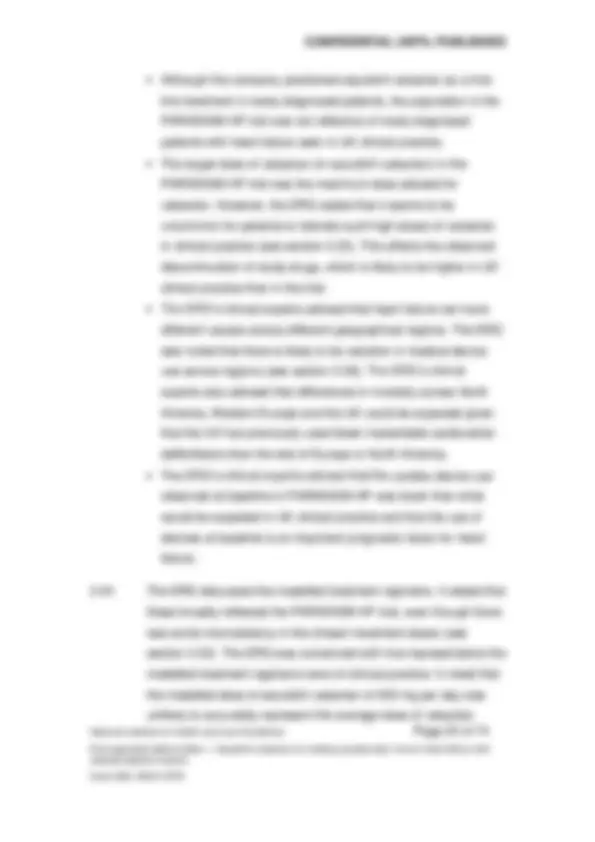
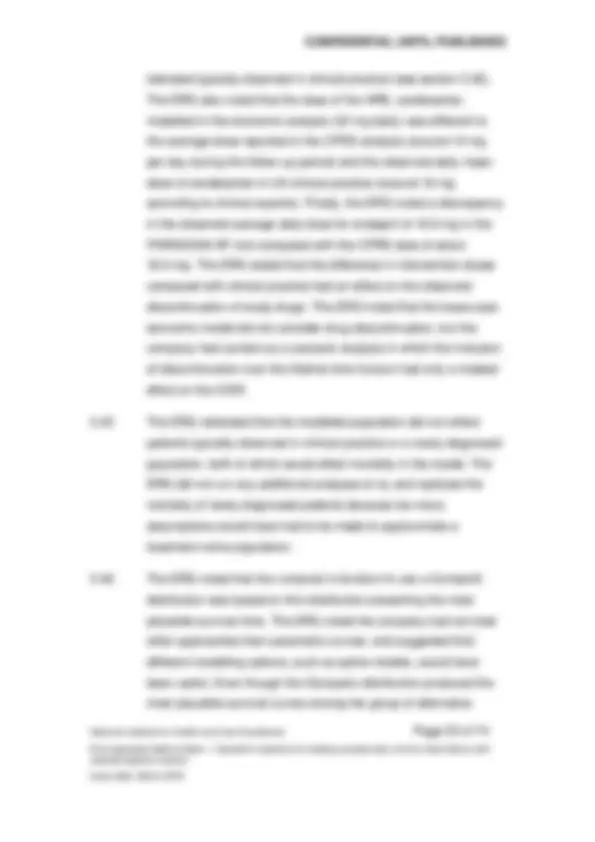
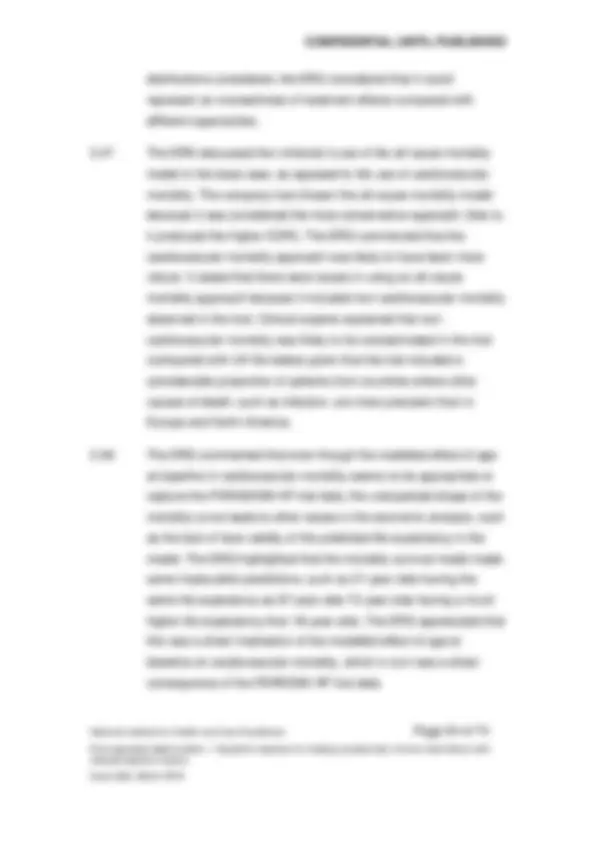
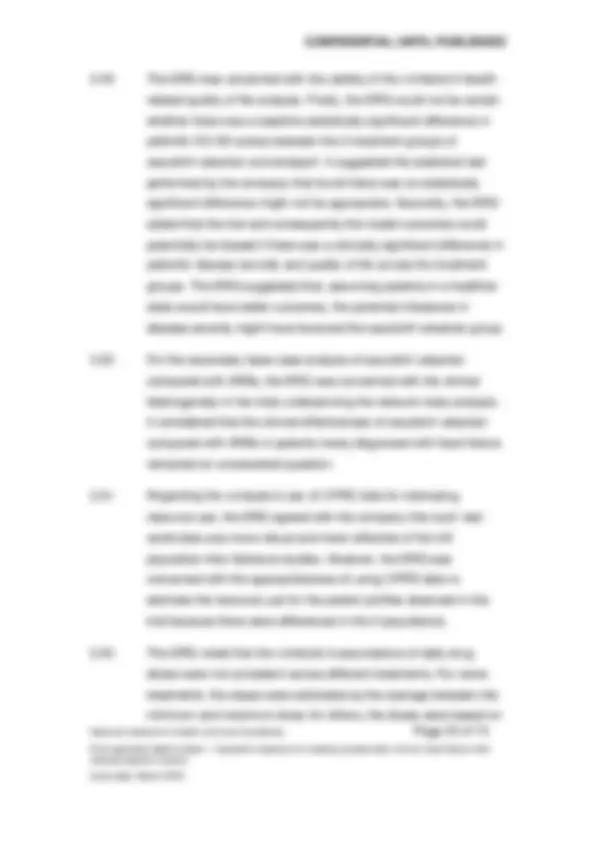
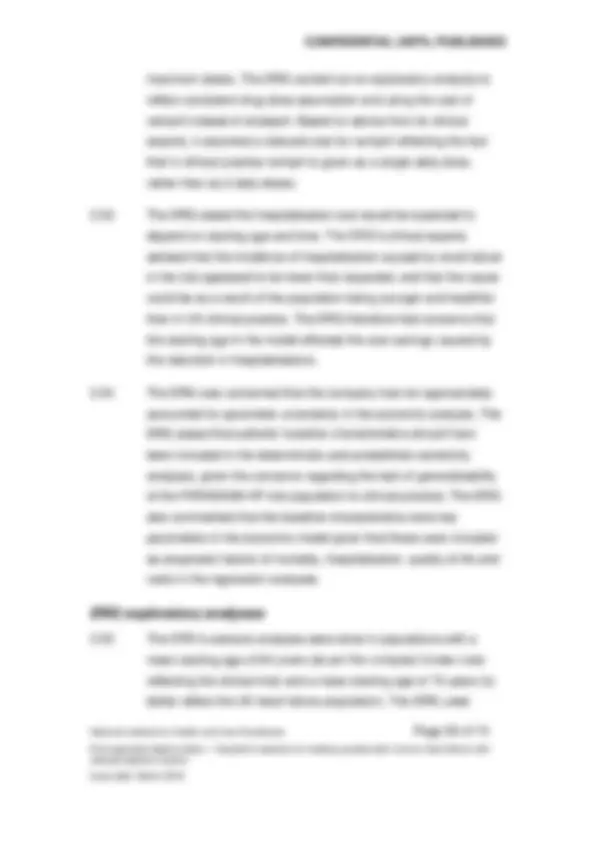
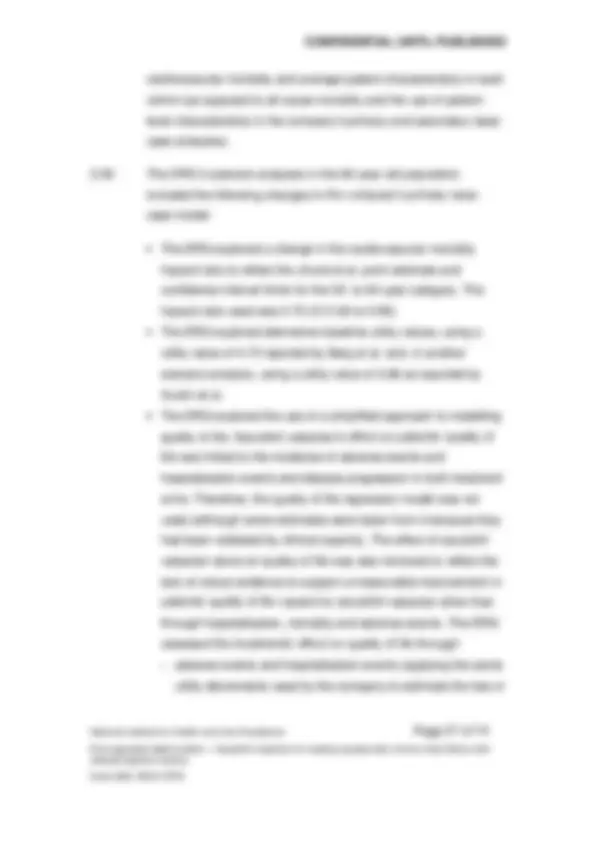
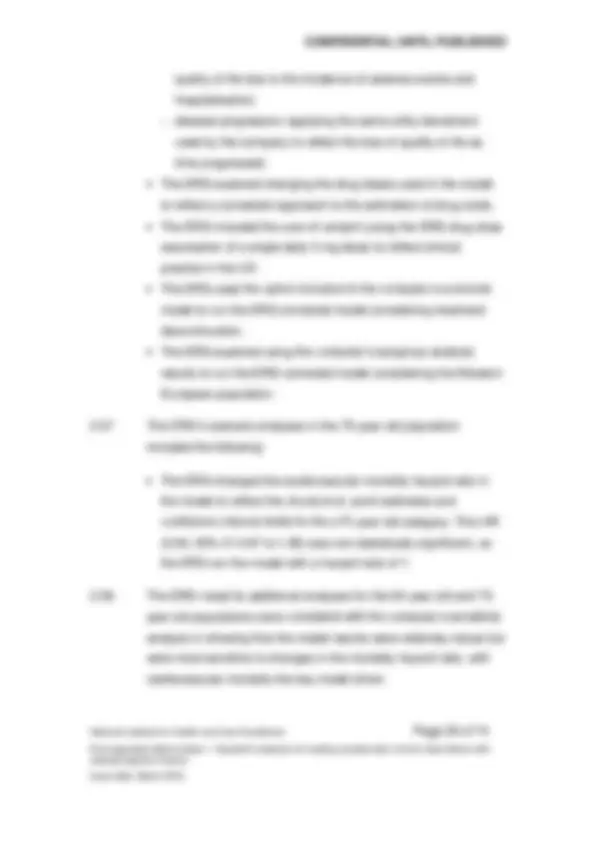
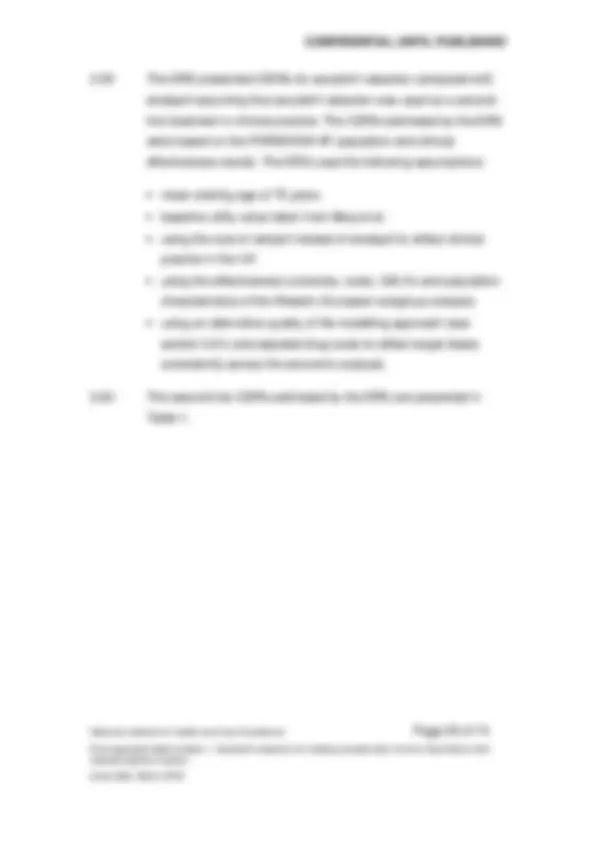
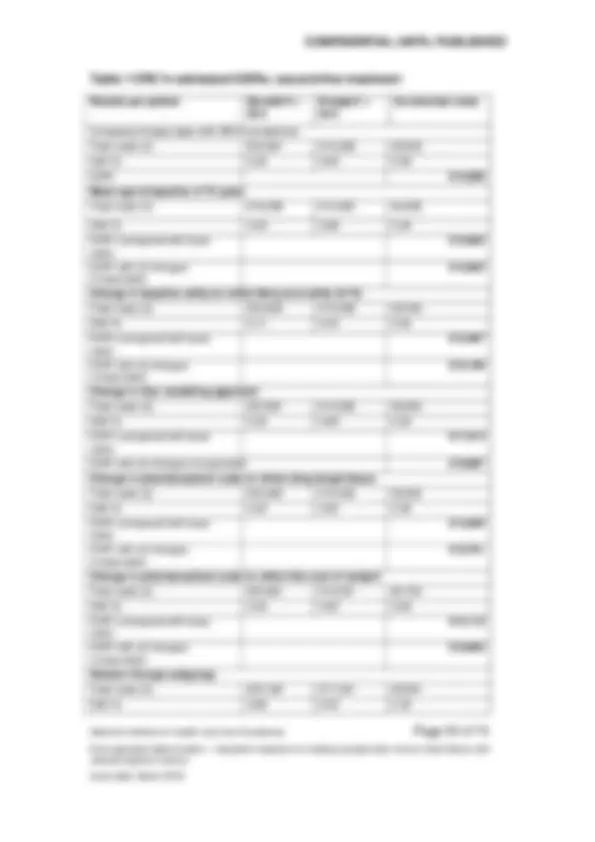
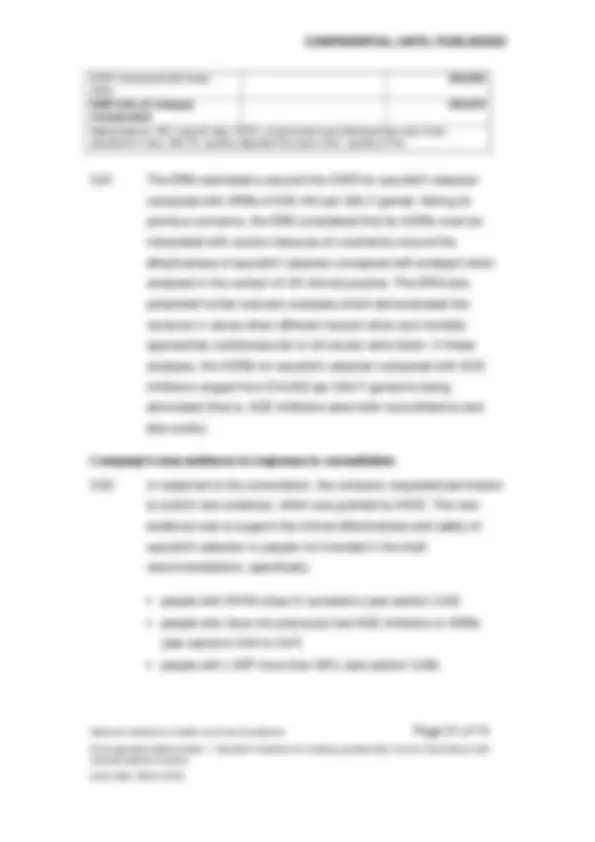
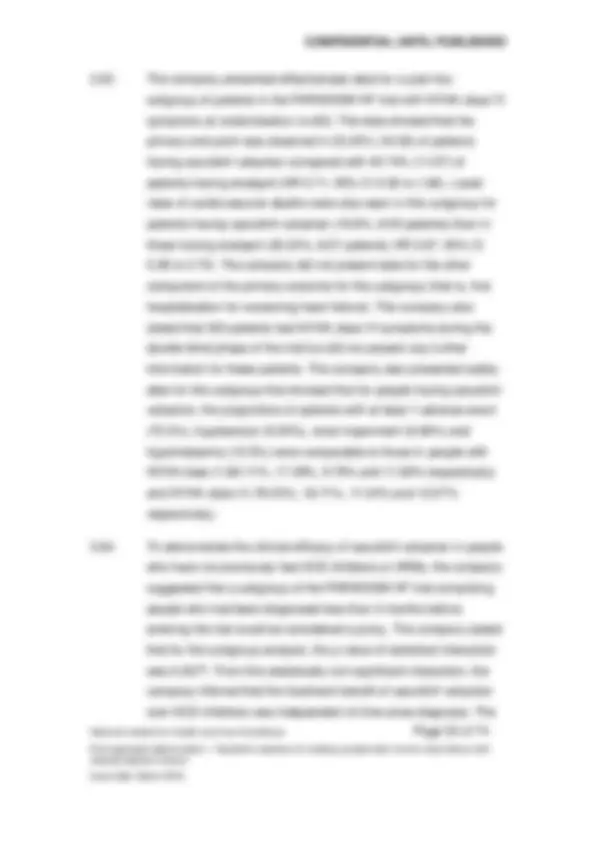
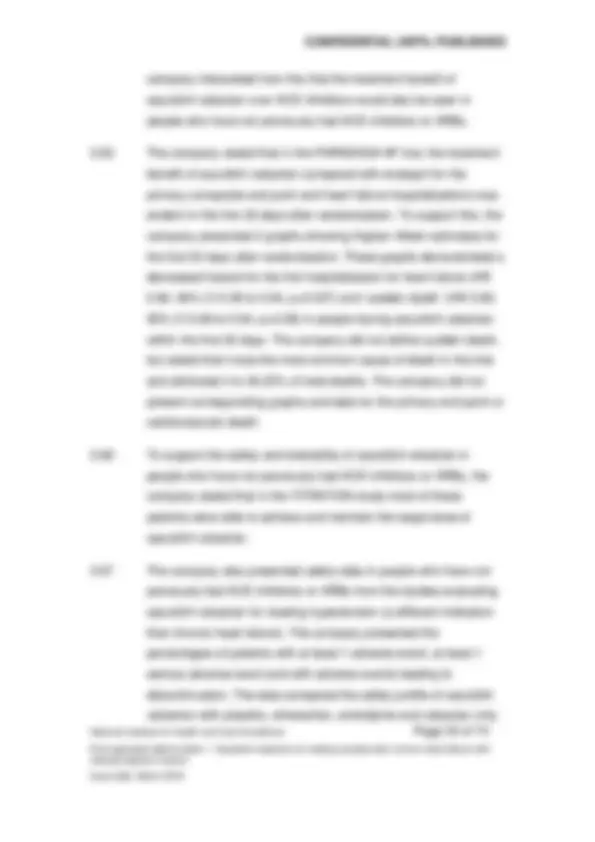
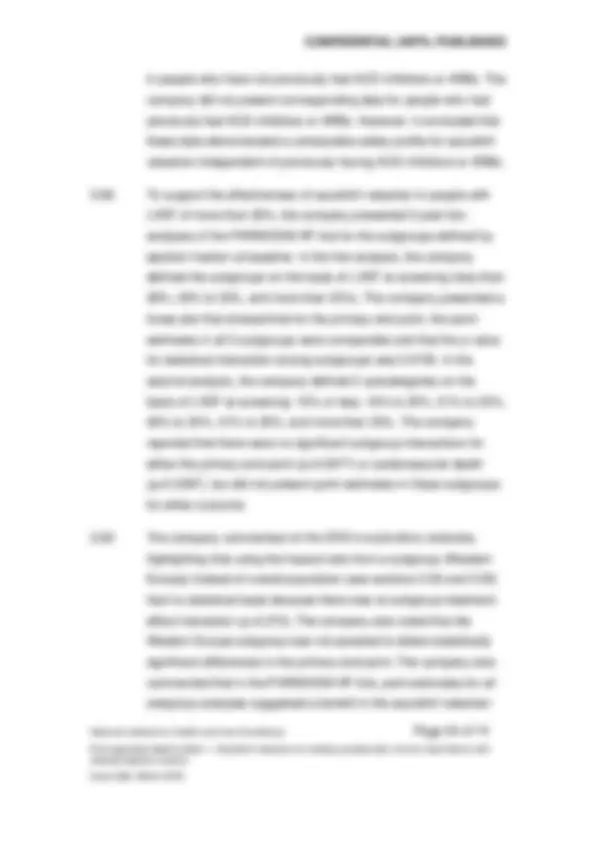
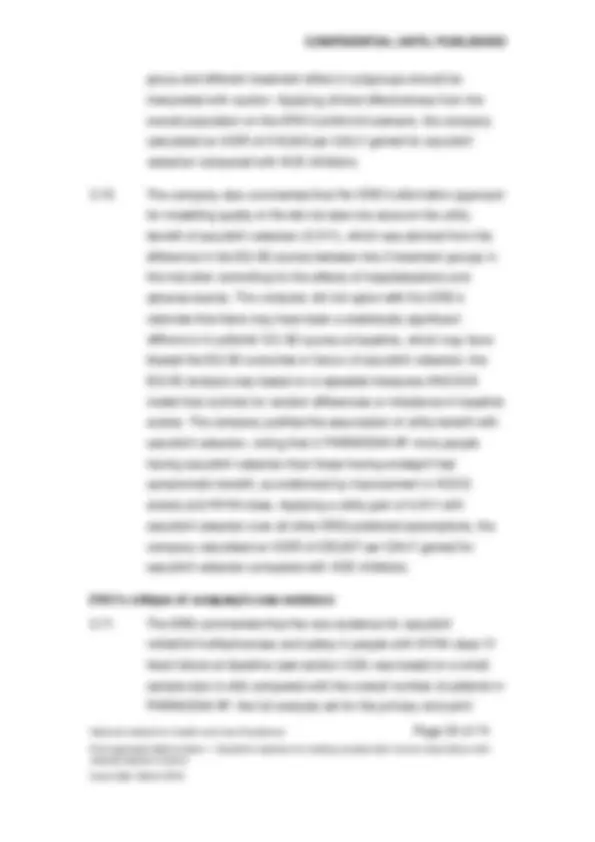
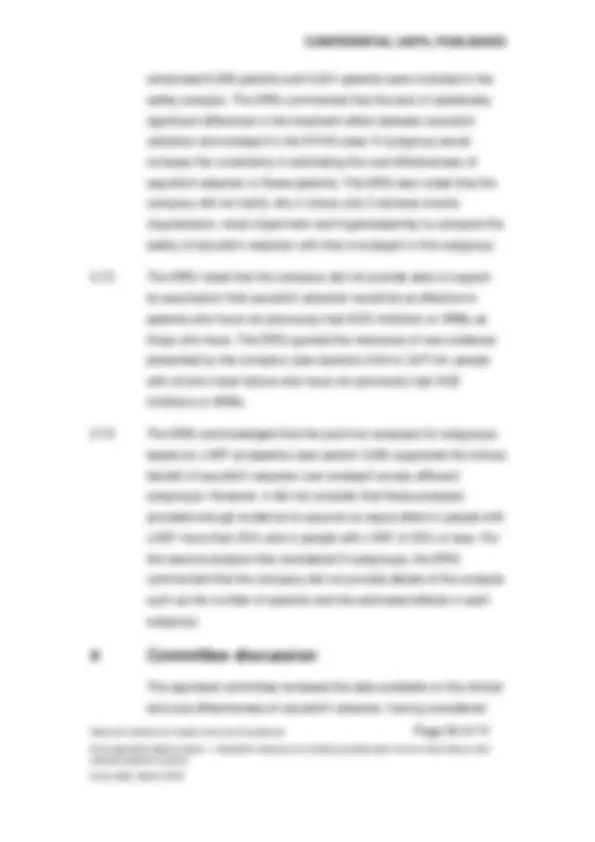
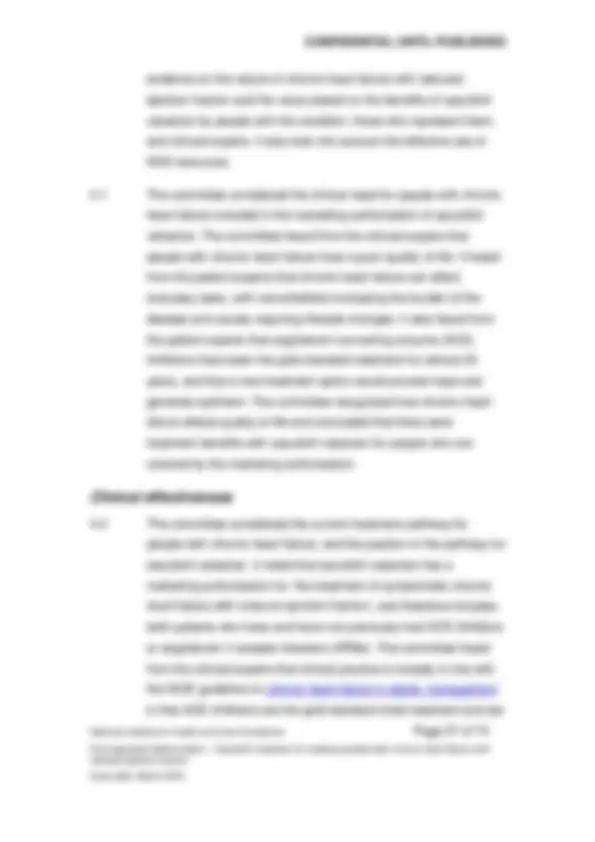
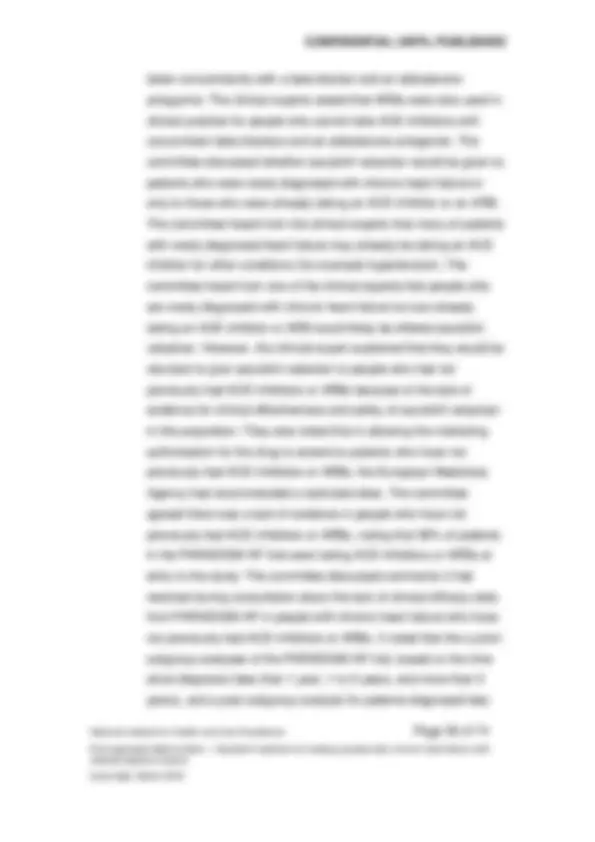
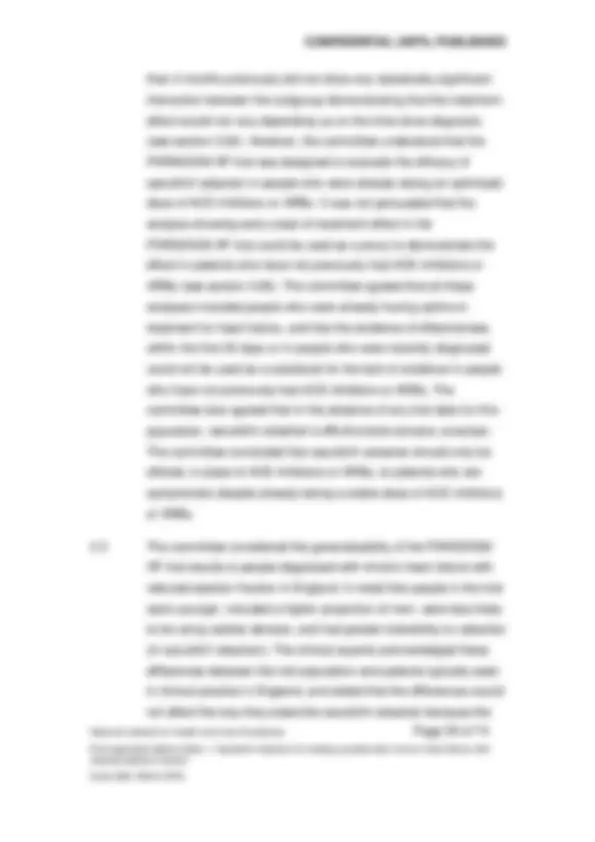
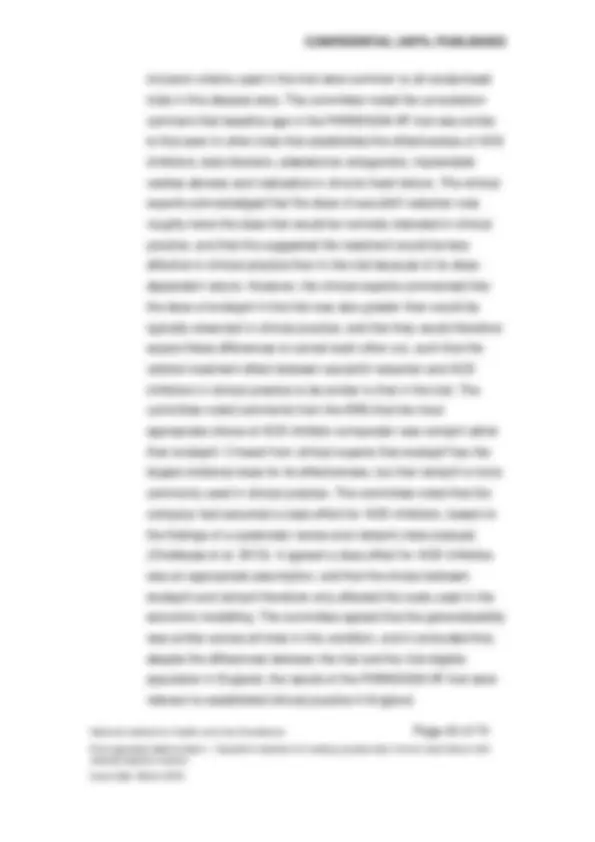
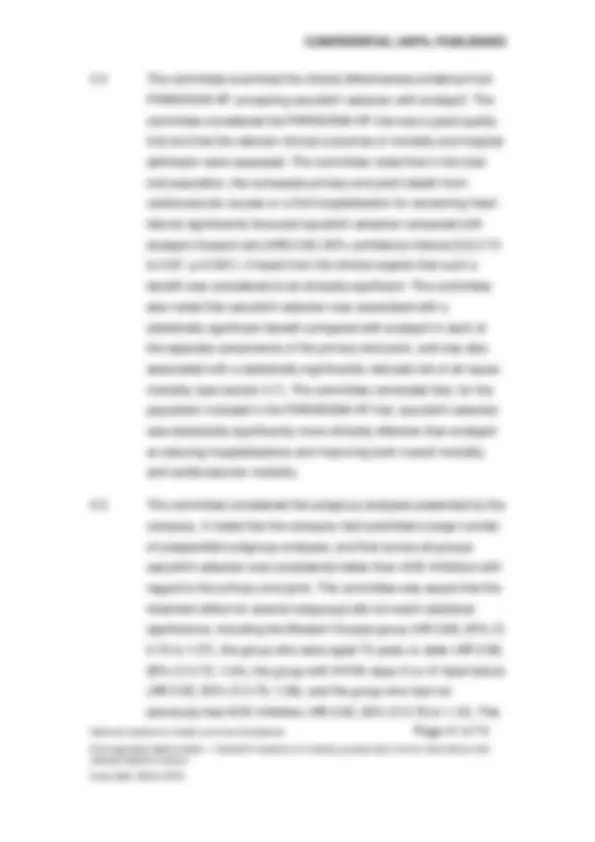
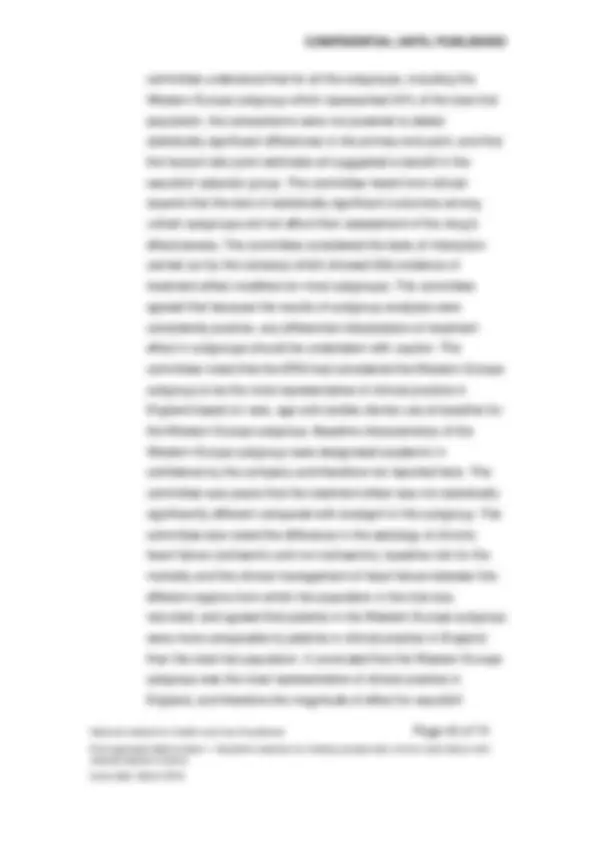
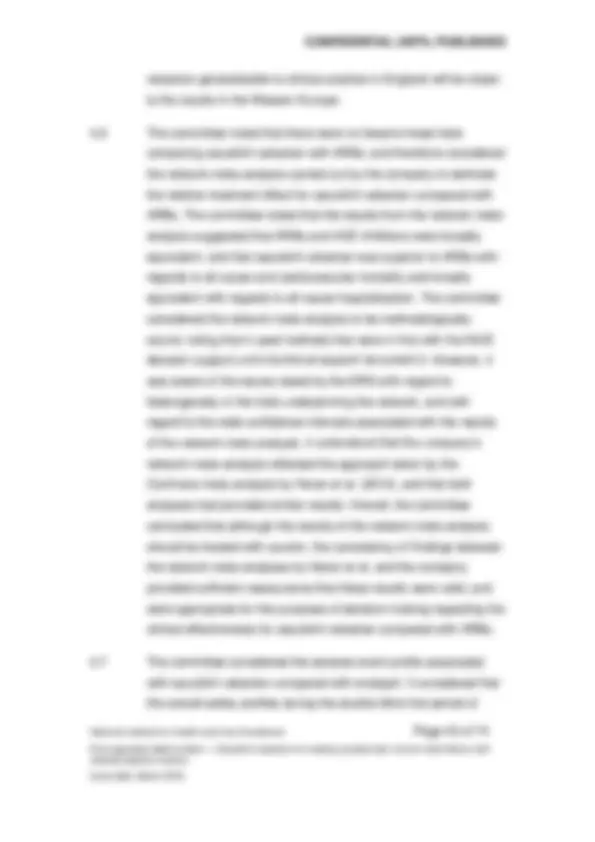
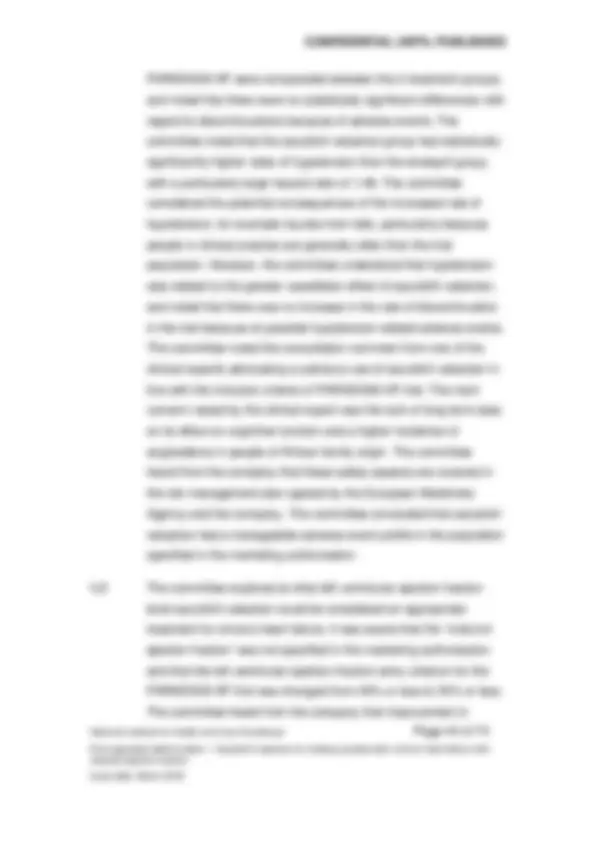
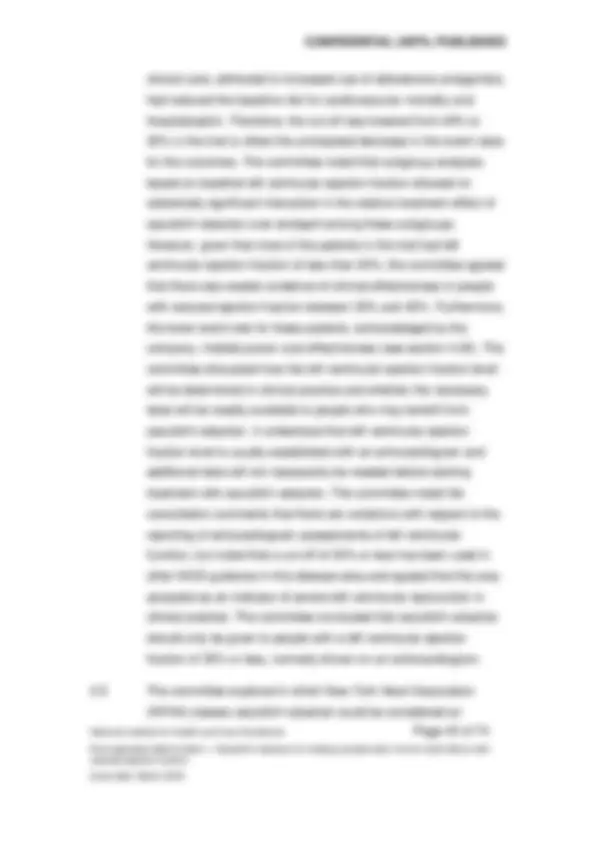
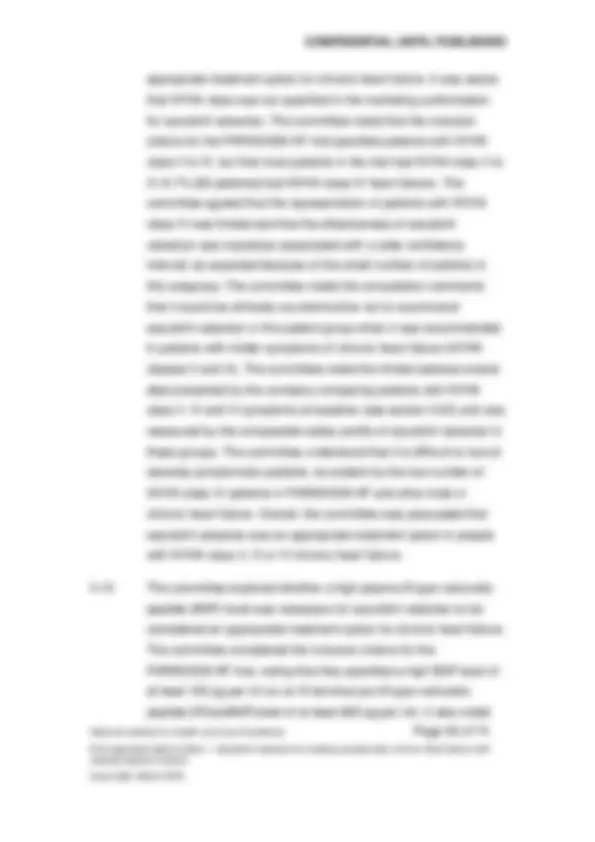
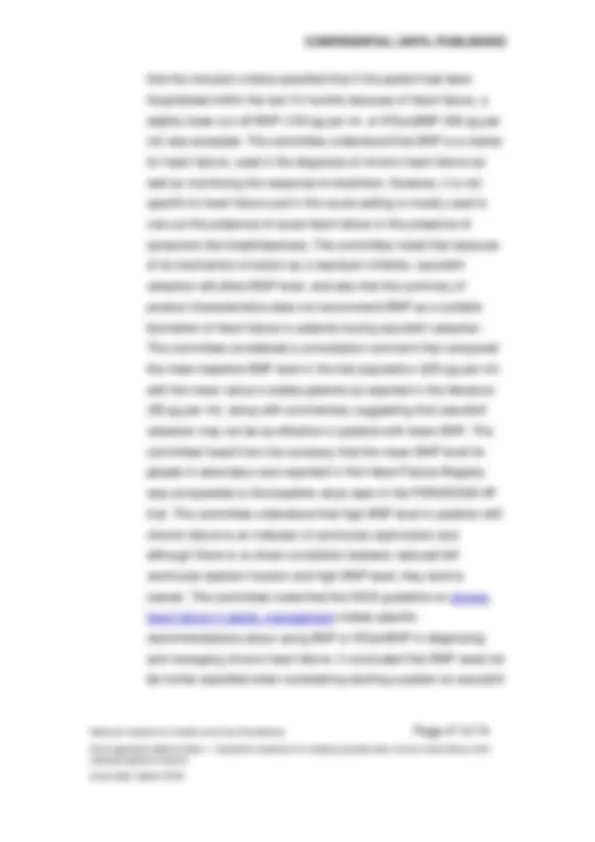
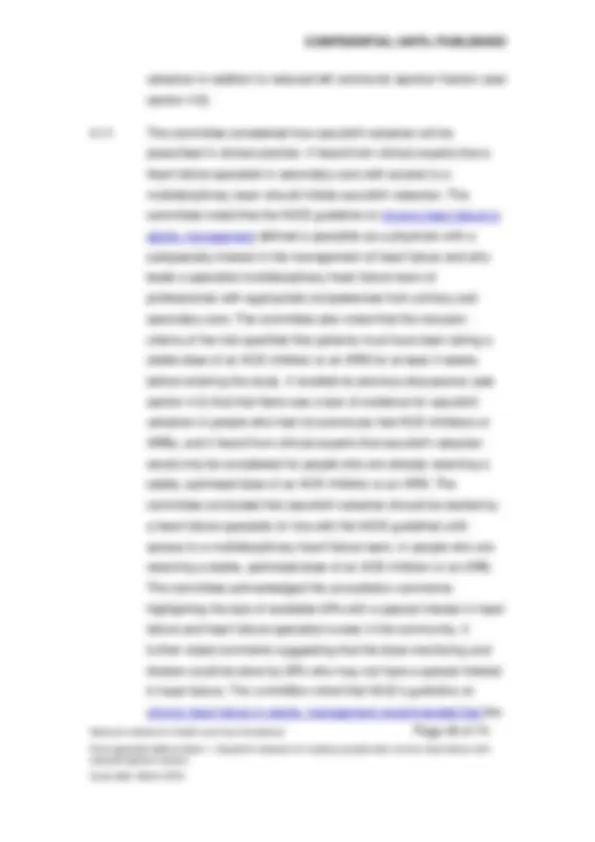
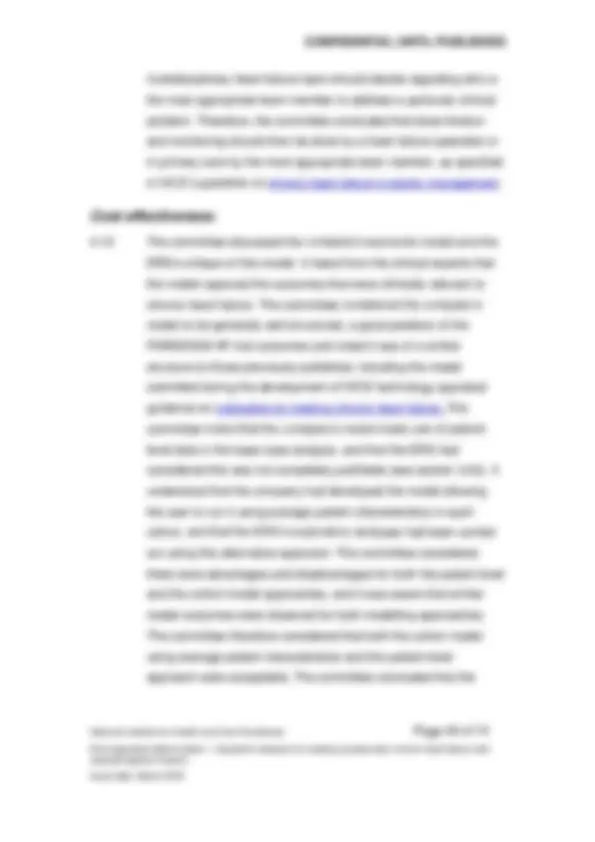
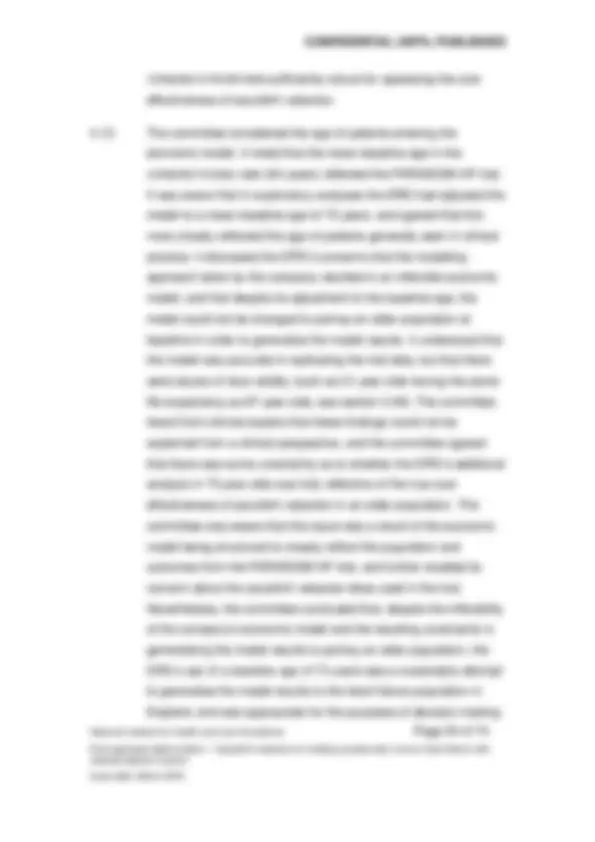
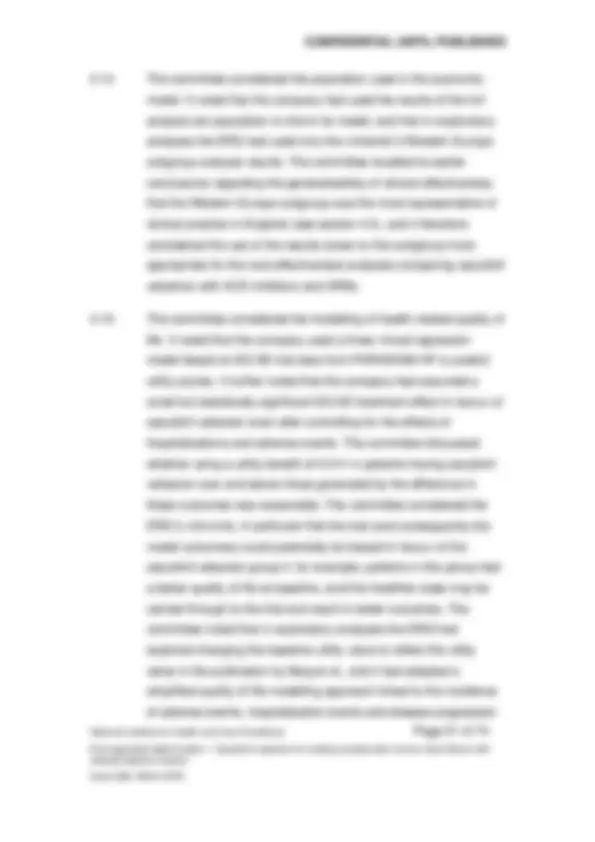
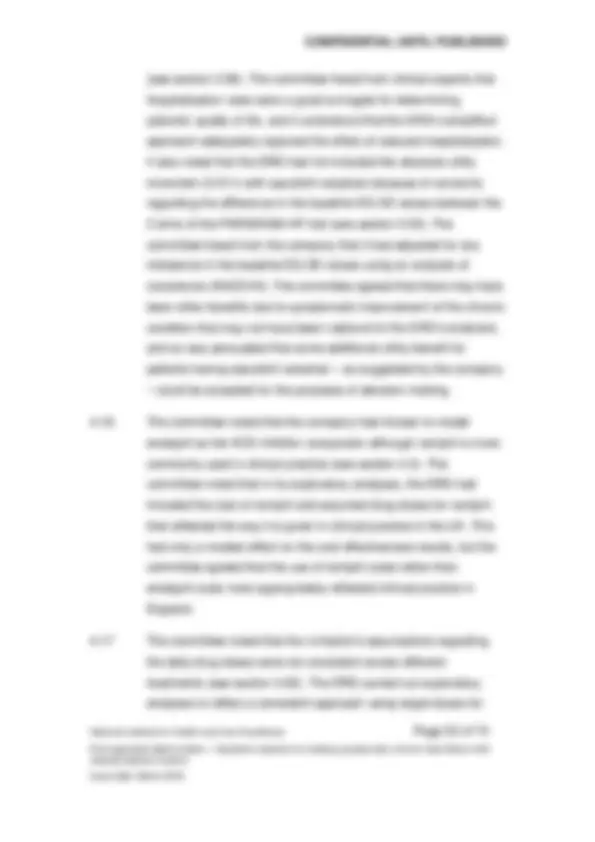
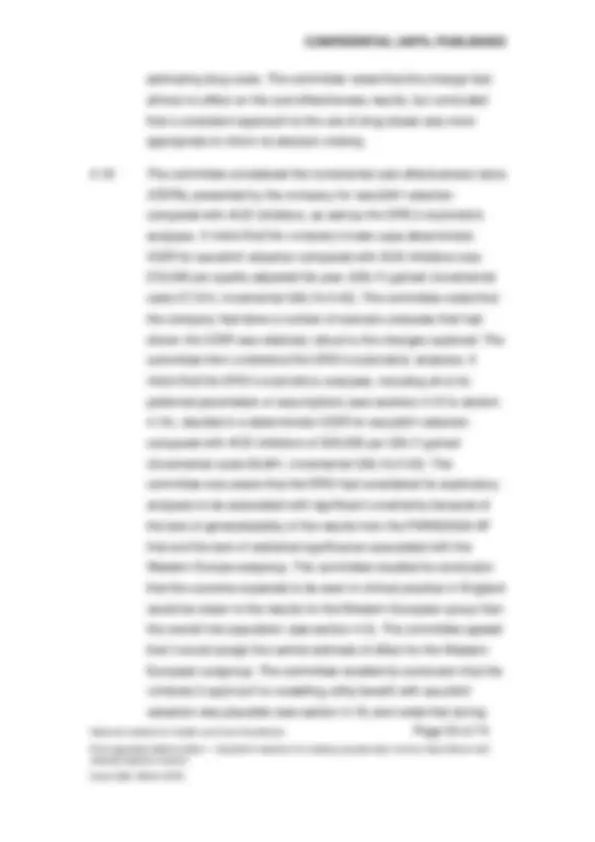
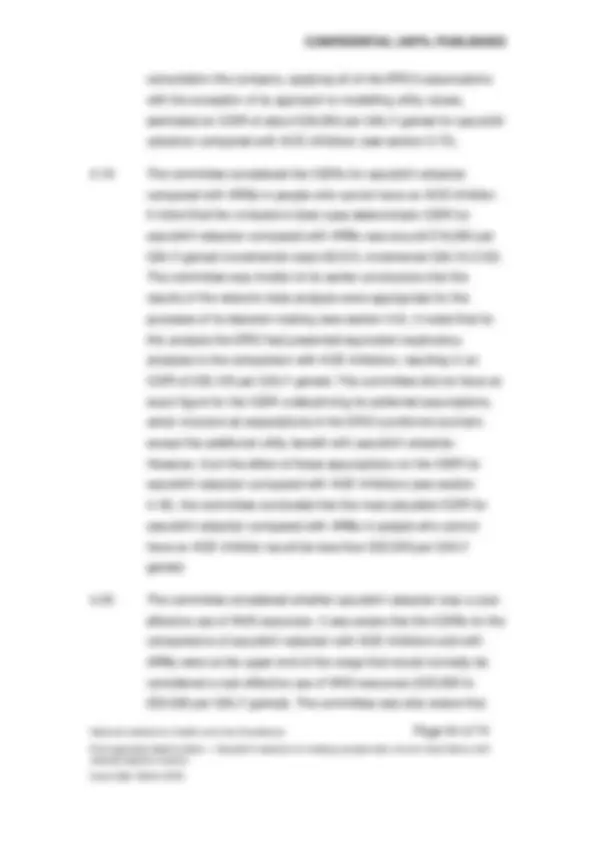
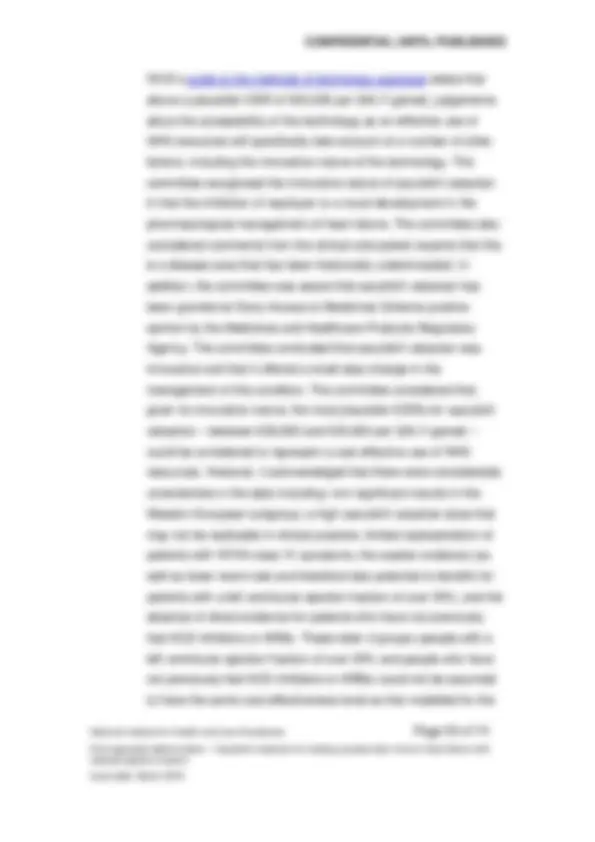
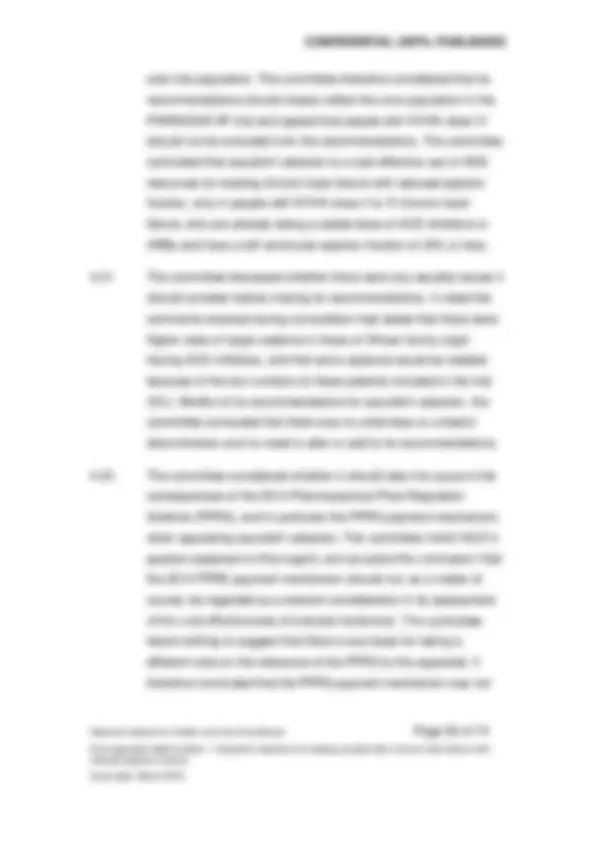
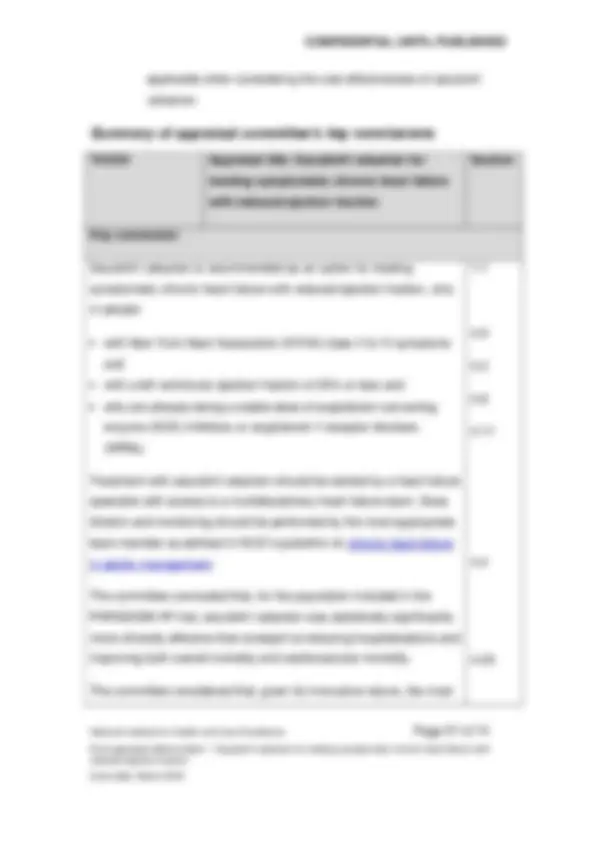
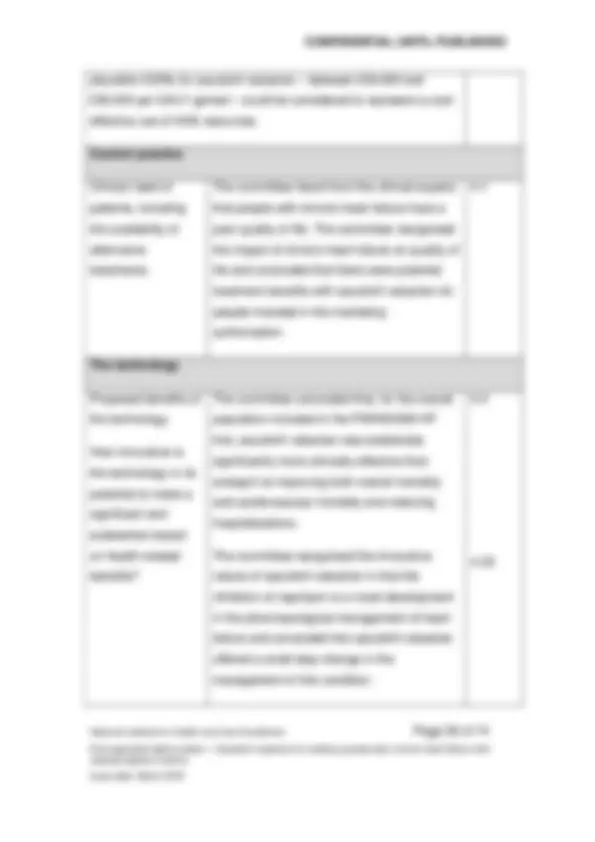
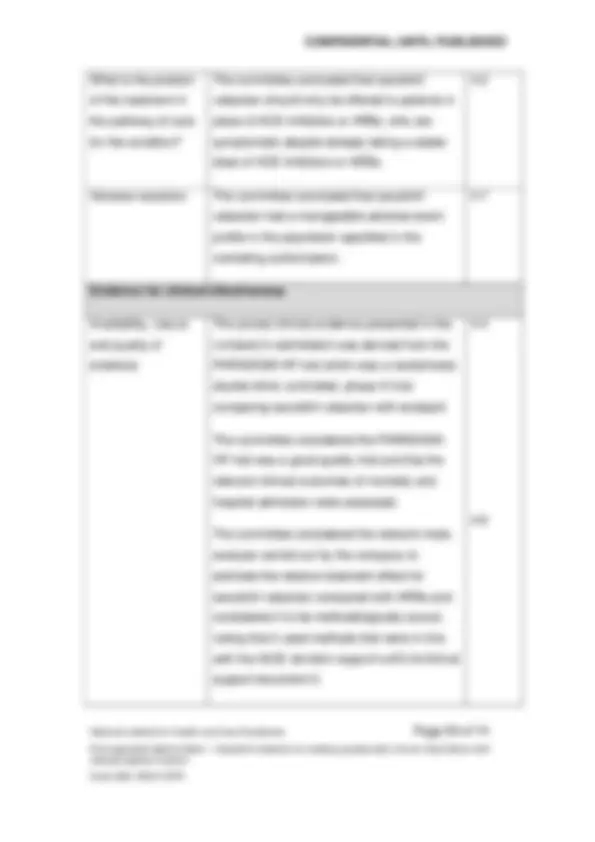
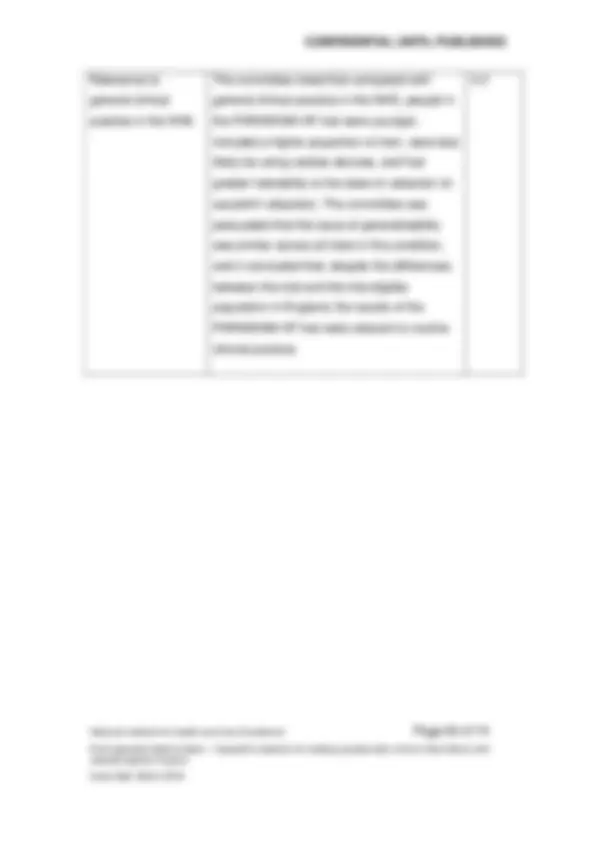
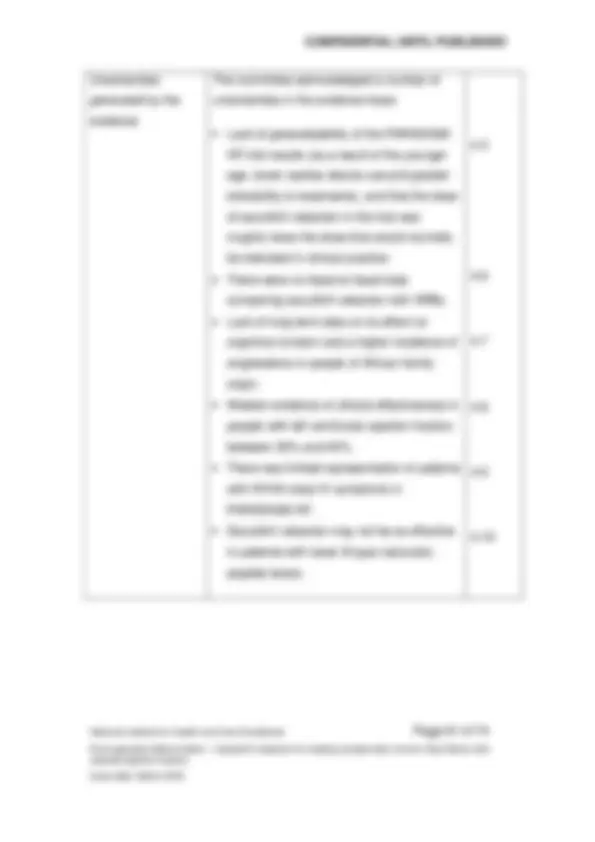
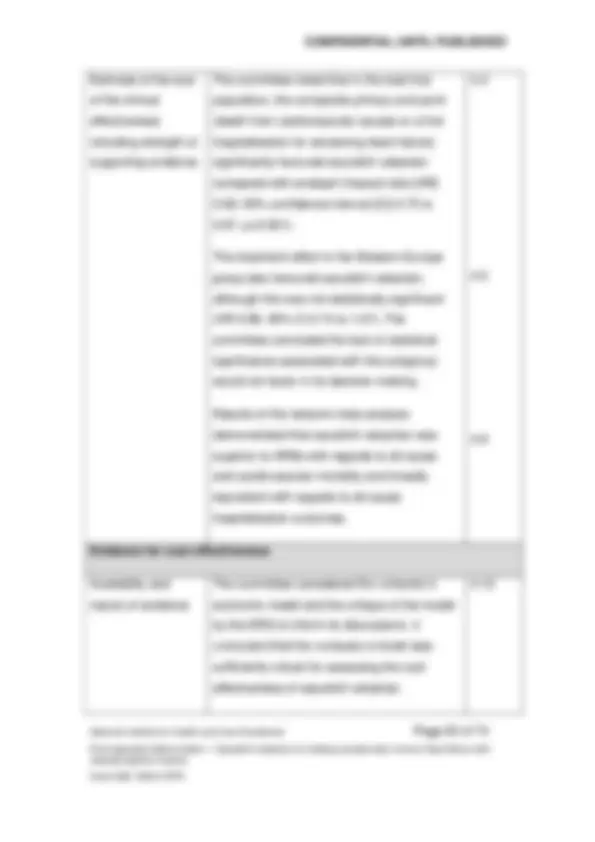
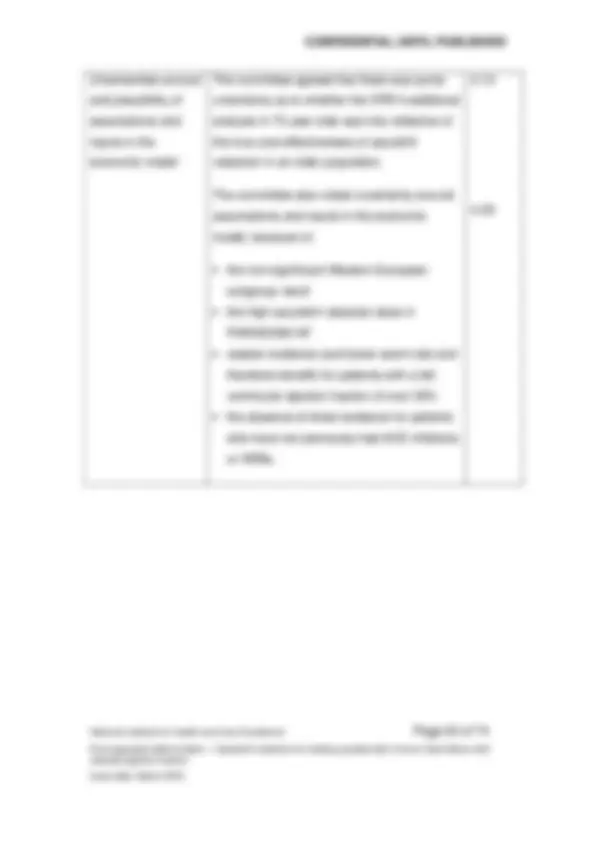
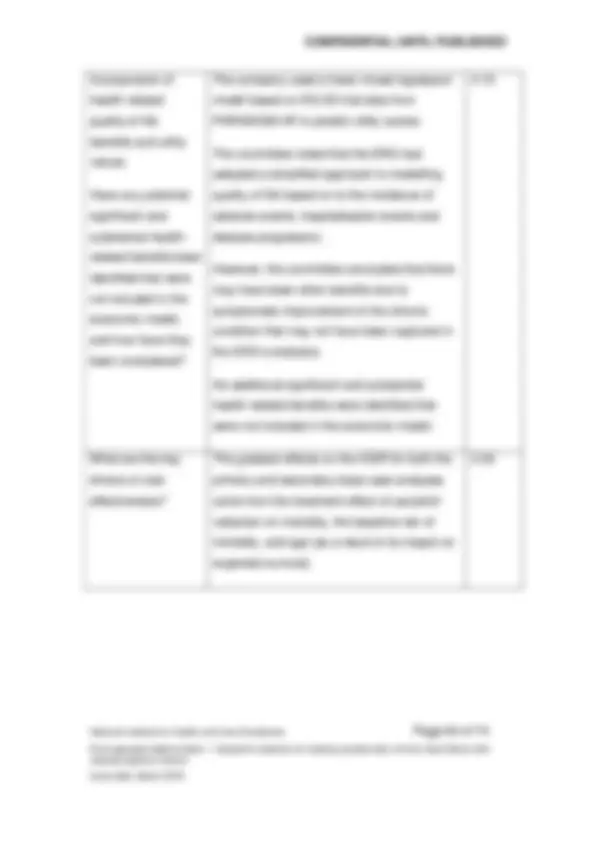
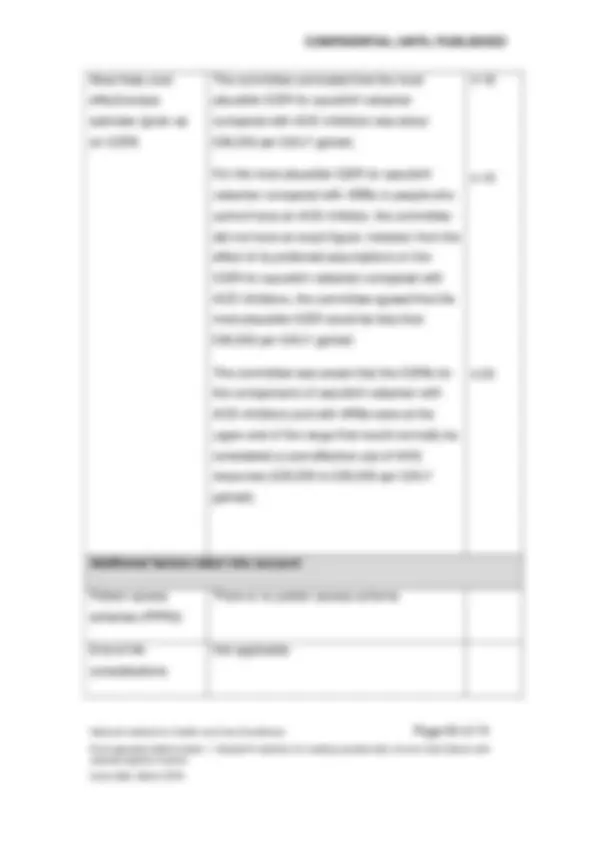
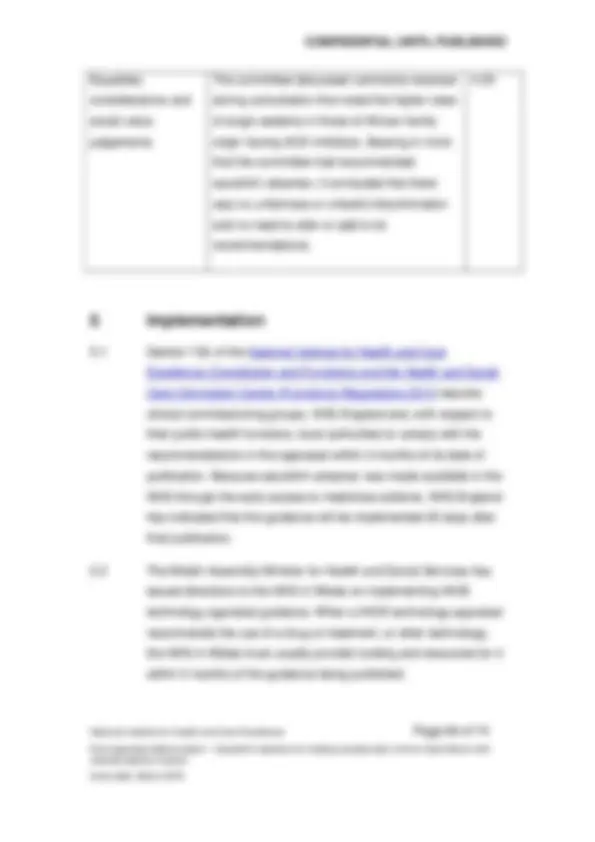
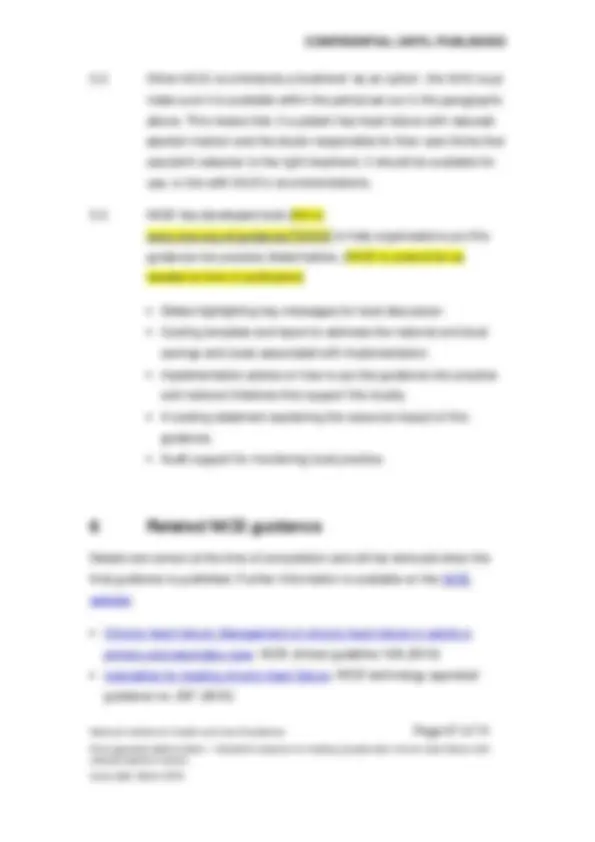
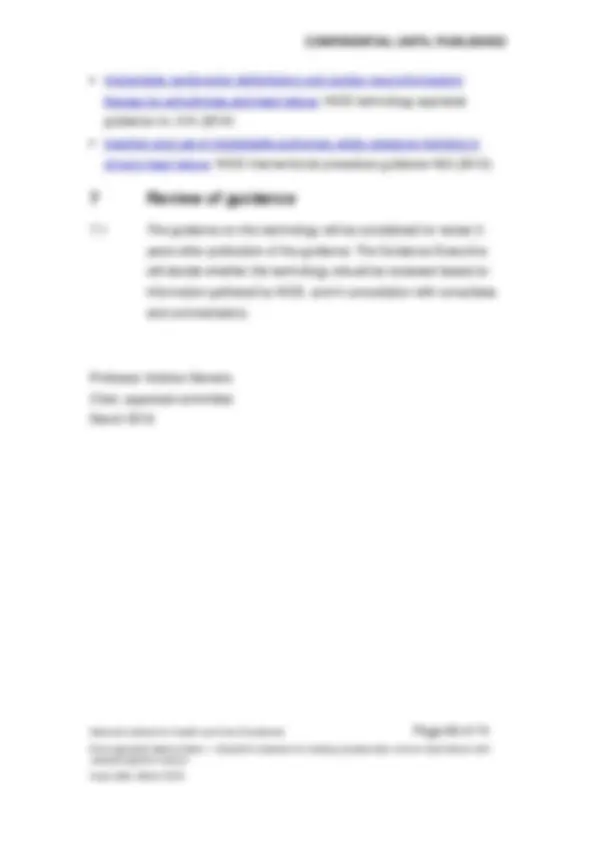
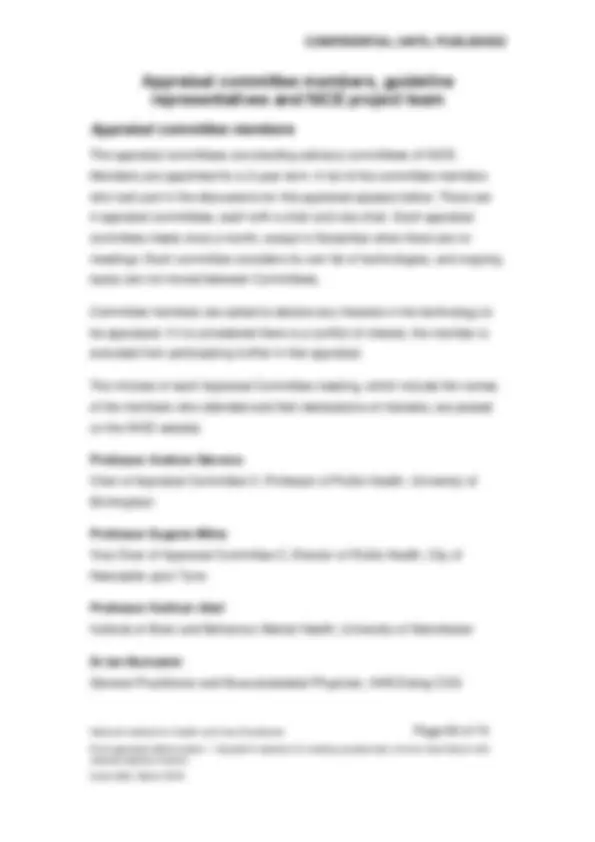
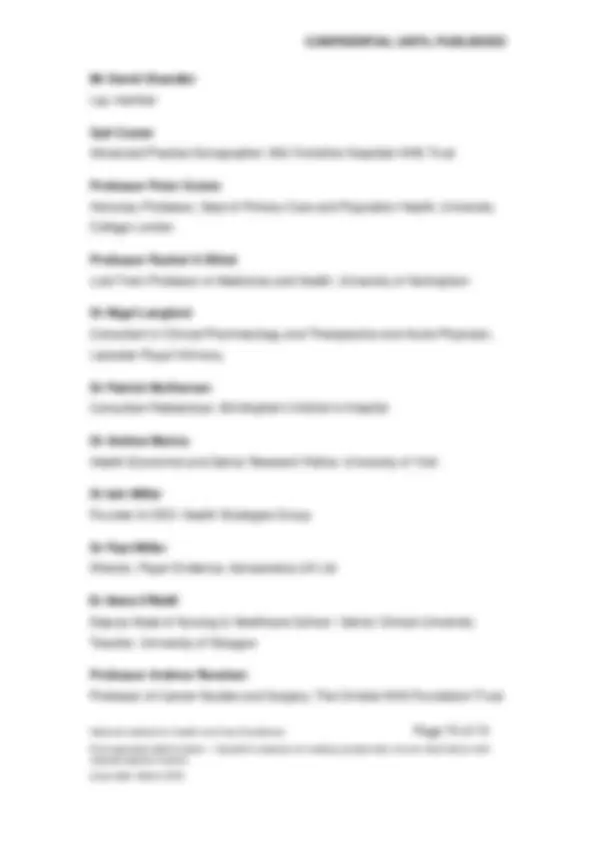
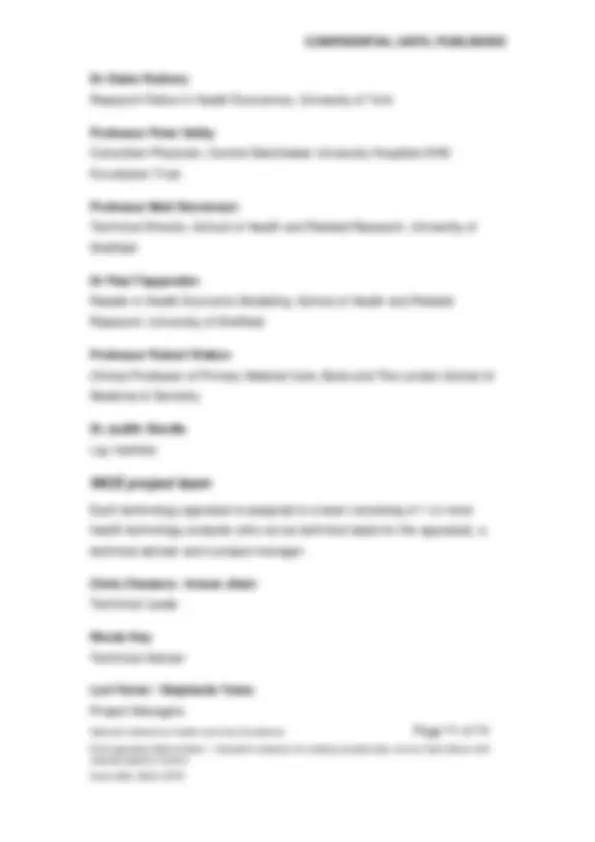
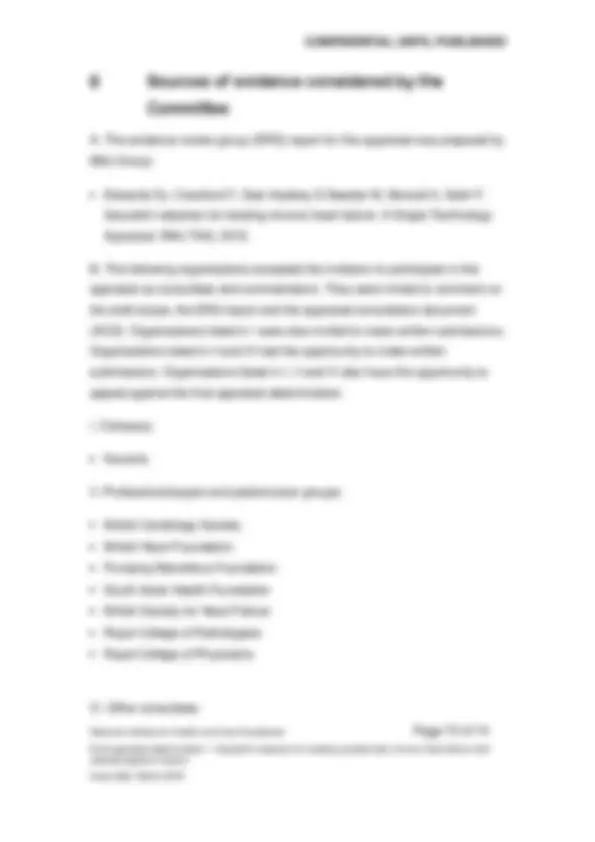
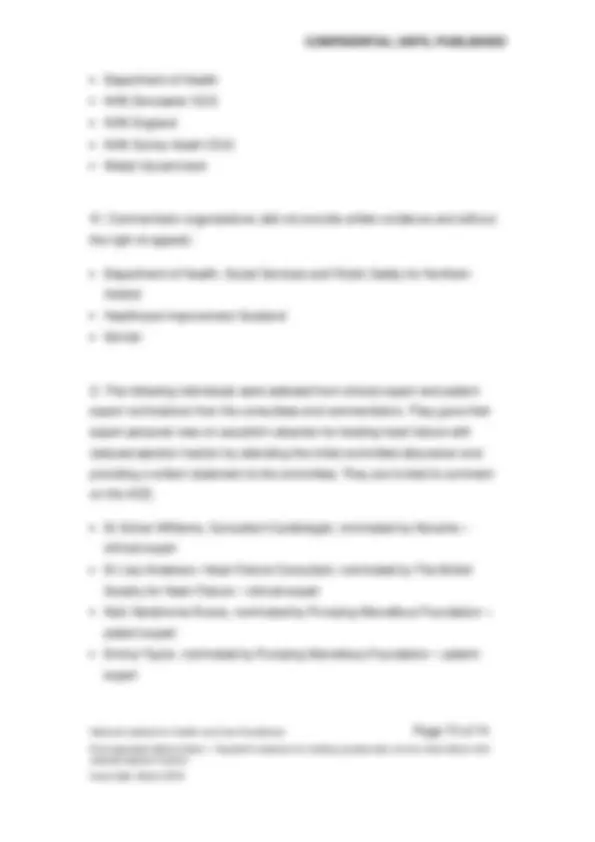
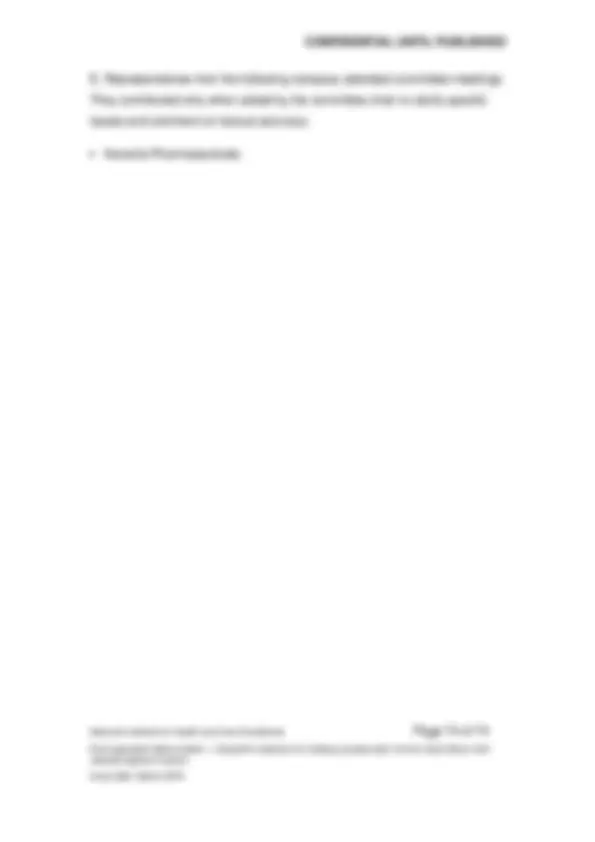


Study with the several resources on Docsity

Earn points by helping other students or get them with a premium plan


Prepare for your exams
Study with the several resources on Docsity

Earn points to download
Earn points by helping other students or get them with a premium plan
Community
Ask the community for help and clear up your study doubts
Discover the best universities in your country according to Docsity users
Free resources
Download our free guides on studying techniques, anxiety management strategies, and thesis advice from Docsity tutors
A final appraisal determination by the National Institute for Health and Care Excellence (NICE) regarding the use of Sacubitril Valsartan for treating symptomatic chronic heart failure with reduced ejection fraction. the recommendations, technology appraisal guidance, and committee discussion on the clinical and cost effectiveness of Sacubitril Valsartan. The document also mentions the safety profile comparison with placebo, olmesartan, amlodipine, and valsartan.
Typology: Slides
1 / 74

This page cannot be seen from the preview
Don't miss anything!



































































National Institute for Health and Care Excellence Page 1 of 74 Final appraisal determination – Sacubitril valsartan for treating symptomatic chronic heart failure with reduced ejection fraction
1.1 Sacubitril valsartan is recommended as an option for treating symptomatic chronic heart failure with reduced ejection fraction, only in people:
with New York Heart Association (NYHA) class II to IV symptoms and with a left ventricular ejection fraction of 35% or less and who are already taking a stable dose of angiotensin-converting enzyme (ACE) inhibitors or angiotensin II receptor-blockers (ARBs).
1.2 Treatment with sacubitril valsartan should be started by a heart failure specialist with access to a multidisciplinary heart failure team. Dose titration and monitoring should be performed by the most appropriate team member as defined in NICE’s guideline on chronic heart failure in adults: management.
2.1 Sacubitril valsartan (Entresto; Novartis) has a UK marketing authorisation for ‘the treatment of symptomatic chronic heart failure
National Institute for Health and Care Excellence Page 2 of 74 Final appraisal determination – Sacubitril valsartan for treating symptomatic chronic heart failure with reduced ejection fraction
with reduced ejection fraction’. Sacubitril valsartan is an angiotensin receptor neprilysin inhibitor, including both a neprilysin inhibitor (sacubitril) and an angiotensin II receptor blocker (ARB; valsartan). Both sacubitril and valsartan lower blood pressure.
2.2 Sacubitril valsartan is administered orally. The recommended starting dose is either 100 mg twice daily, or 50 mg twice daily for people not currently taking (or on low doses of) an angiotensin- converting enzyme (ACE) inhibitor or an ARB. The dose should be doubled every 2 to 4 weeks to the target of 200 mg twice daily, as tolerated by the patient.
2.3 The most commonly reported adverse reactions during treatment with sacubitril valsartan were hypotension, hyperkalaemia and renal impairment. Reported adverse events were generally in line with that reported for other medicinal products acting on the renin- angiotensin-aldosterone system. For full details of adverse reactions and contraindications, see the summary of product characteristics.
2.4 The acquisition cost of sacubitril valsartan is as follows (excluding VAT; price confirmed by company):
50 mg, 28 pack: £45. 100 mg, 28 pack: £45. 100 mg, 56 pack: £91. 200 mg, 56 pack: £91.
Costs may vary in different settings because of negotiated procurement discounts.
National Institute for Health and Care Excellence Page 4 of 74 Final appraisal determination – Sacubitril valsartan for treating symptomatic chronic heart failure with reduced ejection fraction
Screening for inclusion and exclusion criteria. Eligible patients were on a stable dose of an ACE inhibitor or an ARB equivalent to enalapril 10 mg per day for 4 weeks or more before screening visit. Enalapril run-in ( 2 weeks): eligible patients were switched from current medication (ACE inhibitor or ARB) to single-blind treatment with enalapril (10 mg twice daily). Sacubitril valsartan run-in (4 to 6 weeks): patients were eligible if they had no unacceptable side effects in the previous stage. Eligible patients were switched to single-blind treatment with sacubitril valsartan at a dose of 100 mg twice daily, which was increased to 200 mg twice daily during the run-in stage. The 2 run-in stages were sequential, with only a brief (around 36 hours) washout period, and both included all eligible patients. Main trial: patients with no unacceptable side effects after taking target doses of the 2 study medications were randomly assigned (1:1) to double-blinded treatment with either sacubitril valsartan (200 mg twice daily) or enalapril (10 mg twice daily).
3.4 Although the inclusion criteria specified people with NYHA class II to IV, some people had an improvement in their NYHA class between screening and randomisation, so nearly 5% of randomised patients were NYHA class I. The LVEF entry criterion was initially 40% or lower but was subsequently reduced to 35% or lower ( patients were randomised who had LVEF greater than 35%) in order to ensure an adequate event rate in the study population. Hospitalisation for heart failure within the last 12 months was also a necessary inclusion criterion.
3.5 The company stated that at baseline, most characteristics were balanced between the treatment groups, including age, geographic region, NYHA class, standard care or background therapies
National Institute for Health and Care Excellence Page 5 of 74 Final appraisal determination – Sacubitril valsartan for treating symptomatic chronic heart failure with reduced ejection fraction
received, and medical histories. It also commented that patients in the trial were younger (only 49% were 65 years or older) and more likely to be men (just 22% were women) than the general population seen in clinical practice in England. The company reported standard care and background therapies to be comparable to those in clinical practice in England; in the trial, at baseline, 93% of patients had beta blockers and 56% had aldosterone antagonists. About 78% had previously had an ACE inhibitor, and 23% had previously had an ARB. About 30% of people in the trial had been diagnosed with heart failure within the last year, 38% between 1 and 5 years previously, and 32% more than 5 years previously.
3.6 Results were presented based on the full analysis set, which consisted of all patients except those who did not meet the eligibility criteria or did not have a single dose of the study drug. These data were used for the efficacy outcomes (n= 8399 ). The primary end point was a composite of death from cardiovascular causes or a first hospitalisation for worsening heart failure, assessed at every study visit (0, 2, 4 and 8 weeks, 4 months, and then every 4 months). The composite primary end point significantly favoured sacubitril valsartan compared with enalapril (hazard ratio [HR] 0.80; 95% confidence interval [CI] 0.73 to 0.87, p<0.001).
3.7 The secondary outcomes included:
all-cause mortality (assessed at all study visits) change from baseline to 8 months in the clinical summary score on the Kansas City Cardiomyopathy Questionnaire (KCCQ); patient scores were assessed at baseline/randomisation visit (visit 5), at 4, 8 and 12 months (visits 8, 9 and 10), at 24 and 36 months (visits 14 and 17), and at the end of study visit.
National Institute for Health and Care Excellence Page 7 of 74 Final appraisal determination – Sacubitril valsartan for treating symptomatic chronic heart failure with reduced ejection fraction
the primary composite outcome of death from cardiovascular causes or a first hospitalisation for worsening heart failure, but this was not statistically significant (HR 0.92, 95% CI 0.76 to 1.10).
3.11 The NICE scope specified the comparator for people who cannot have an ACE inhibitor to be an ARB in combination with standard care. Because there is no head-to-head evidence comparing sacubitril valsartan with ARBs, the company conducted a network meta-analysis to inform the economic model with estimates of the effectiveness of sacubitril valsartan compared with ARBs, as well as the effectiveness of ARBs compared with ACE inhibitors.
3.12 The network meta-analysis was based on data from 28 randomised controlled trials and provided comparative evidence for all-cause mortality (28 trials, 4 treatment comparisons), cardiovascular mortality (13 trials, 4 treatment comparisons) and all-cause hospitalisations (28 trials, 4 treatment comparisons). The company commented that the network meta-analysis reflected the approach taken by Heran et al. (2012) in a Cochrane review, which assessed ACE inhibitors against ARBs with regard to morbidity and mortality irrespective of concomitant treatment with standard care therapies.
3.13 The company’s network meta-analysis categorised treatment by class (angiotensin receptor neprilysin inhibitor [ARNI; sacubitril valsartan], ACE inhibitors, ARBs and placebo), assuming equal efficacy across all treatments in each class. To justify the class- effect assumption of ACE inhibitors, the company referenced a systematic review and network meta-analysis by Chatterjee et al. (2013) which found that ‘there is currently no statistical evidence in support of the superiority of any single agent over the others’. The company cited the Cochrane review by Heran et al. (2012) to support the assumption of a class effect for ARBs.
National Institute for Health and Care Excellence Page 8 of 74 Final appraisal determination – Sacubitril valsartan for treating symptomatic chronic heart failure with reduced ejection fraction
3.14 The company used a Bayesian framework for its network meta- analysis. The Bayesian network meta-analysis random effects model outcomes included all-cause mortality, cardiovascular mortality and all-cause hospitalisations. The results of the network meta-analysis presented by the company were designated academic in confidence and cannot be reported here. However, the results demonstrated that:
ARBs and ACE inhibitors were broadly equivalent sacubitril valsartan was superior to ARBs with regards to all- cause and cardiovascular mortality and broadly equivalent with regards to all-cause hospitalisation outcomes sacubitril valsartan was superior to ACE inhibitors with regards to all-cause and cardiovascular mortality and superior with regards to all-cause hospitalisation.
3.15 The overall safety profile of sacubitril valsartan was comparable to that of the ACE inhibitor, enalapril, during the double-blind trial period of PARADIGM-HF. Compared with the enalapril group, fewer patients in the sacubitril valsartan group experienced 1 or more treatment-related adverse events, 1 or more serious adverse events, death or discontinued as a result of an adverse event. Treatment with sacubitril valsartan was associated with higher rates of hypotension. The company noted this was a result of sacubitril valsartan’s greater vasodilator effect, and that there was no increase in the rate of discontinuation because of possible hypotension-related adverse effects. Fewer patients having sacubitril valsartan experienced renal adverse events compared with those having enalapril, which was driven by a lower incidence of renal impairment and renal failure in the sacubitril valsartan group (10.14% and 2.66% respectively) compared with the enalapril group (11.52% and 3.41% respectively). Other adverse
National Institute for Health and Care Excellence Page 10 of 74 Final appraisal determination – Sacubitril valsartan for treating symptomatic chronic heart failure with reduced ejection fraction
probabilistic sensitivity analyses were also done to explore parameter uncertainty in the model.
3.18 The model population characteristics were based on the full analysis set population of PARADIGM-HF (see section 3.6). Baseline characteristics were used as covariates in the regression models to estimate mortality, hospitalisation and quality of life in the economic analysis.
3.19 In both treatment and comparator arms of the model, a proportion of patients had standard care (and other background therapies) in addition to sacubitril valsartan or enalapril (or candesartan). Standard care was defined as beta blockers and aldosterone antagonists. Additional background therapies consisted of diuretics, digoxin, anticoagulants, aspirin, adenosine diphosphate antagonists and lipid-lowering drugs.
3.20 The company’s primary base-case analysis for sacubitril valsartan compared with enalapril modelled the likelihood of a patient experiencing a hospitalisation event using a negative binomial regression model. Predicted all-cause hospitalisation rates were determined by the treatment the patient had (sacubitril valsartan or enalapril) and patients’ baseline characteristics, taken from the PARADIGM-HF trial. These were used to inform the number of hospitalisations occurring in the initial period of the economic analysis, but also allowed for extrapolation beyond the follow-up of the PARADIGM-HF trial. The rate of hospitalisation was assumed constant over time, therefore assuming that hospitalisation was not related to disease progression over time.
3.21 In the company’s primary base-case analysis, transition probabilities between the alive and dead health states were taken from all-cause mortality data from PARADIGM-HF in the base
National Institute for Health and Care Excellence Page 11 of 74 Final appraisal determination – Sacubitril valsartan for treating symptomatic chronic heart failure with reduced ejection fraction
case. All-cause mortality was estimated with survival regression analysis. The company chose the Gompertz distribution for its base case, noting that its clinical experts considered it to be clinically plausible, that it provided the most conservative (shortest) estimate of survival benefit, and that it was used in NICE technology appraisal guidance on ivabradine for treating chronic heart failure’. Predicted all-cause mortality was determined by the treatment the patient had (sacubitril valsartan or enalapril) and patients’ baseline characteristics, taken from the PARADIGM-HF trial. The mortality model was run using the full analysis set population of the PARADIGM-HF trial and the model outputs provided daily hazard rates. These were used to model the probability of patients dying in the initial period of the economic analysis but also allowed for extrapolation of mortality beyond the end of the PARADIGM-HF trial for the remainder of the modelled time horizon. In an alternative analysis, the company derived transition probabilities between the alive and dead health states from cardiovascular- related mortality. The Gompertz distribution was also used for this analysis.
3.22 The company used a linear mixed regression model based on EQ- 5D trial data from PARADIGM-HF to predict the utility scores for patients in the base-case analysis. Since the economic model did not explicitly include mutually exclusive health states (other than the alive and the dead states), mean utility values over time were calculated for each patient profile. Predicted EQ-5D scores were based on which treatment the patient had, baseline characteristics (including baseline EQ-5D), and risk of hospitalisation and adverse events.
3.23 A small but statistically significant EQ-5D treatment effect in favour of sacubitril valsartan was assumed after controlling for the effects
National Institute for Health and Care Excellence Page 13 of 74 Final appraisal determination – Sacubitril valsartan for treating symptomatic chronic heart failure with reduced ejection fraction
based on the full analysis set population. The company modelled the adverse events by assuming a constant probability of a specific adverse event occurring each cycle. It assumed that all-cause hospitalisation included all the relevant serious adverse events, including the associated costs and how it affects patients’ quality of life. Adverse events in the trial that were designated non-serious were modelled independently from hospitalisation. These were hypotension, elevated serum creatinine, elevated serum potassium, cough and angioedema. Adverse events in the secondary analysis in the ARB treatment arm of the model were assumed to be equivalent to the sacubitril valsartan treatment arm.
3.27 Resource use and costs considered in the model included:
intervention and comparator costs (including background therapies) treatment initiation costs hospitalisation costs heart failure management costs adverse event costs.
3.28 The company based the daily costs of ACE inhibitors and sacubitril valsartan on observed doses from PARADIGM-HF. The cost of hospitalisation was based on healthcare resource groups mapped from physician-reported diagnoses, surgeries and interventional procedures that could be classified, and medical management hospitalisations with more than 30 instances considered. Typical costs of standard care (including beta blockers and aldosterone antagonists) and background medications were based on recommended doses. Estimates of background resource use, including emergency department referrals, outpatient contacts and GP visits, were taken from relevant national sources. A Clinical
National Institute for Health and Care Excellence Page 14 of 74 Final appraisal determination – Sacubitril valsartan for treating symptomatic chronic heart failure with reduced ejection fraction
Practice Research Datalink (CPRD) analysis commissioned by the company in order to characterise the burden of illness in the UK for patients with heart failure was used as the main source for resource use in the base case.
3.29 The primary base-case deterministic incremental cost-effectiveness ratio (ICER) for sacubitril valsartan compared with ACE inhibitors was £ 17 , 939 per quality-adjusted life year (QALY) gained (representing incremental costs of £ 7 , 514 and incremental QALYs of 0.42), and the probabilistic ICER was £18, 818 per QALY gained. The probabilities of sacubitril valsartan being cost effective at the maximum acceptable ICERs of £20,000 and £30,000 per QALY gained were 64% and 93% respectively.
3.30 Deterministic one-way sensitivity analysis showed that for the comparison with ACE inhibitors the ICER was most sensitive to all- cause mortality, with the greatest effects on the ICER coming from the treatment effect of sacubitril valsartan on all-cause mortality, the baseline risk of all-cause mortality, and age (as a result of its effect on expected survival). Variables which had a modest effect included the improvements in health-related quality of life and reduction in hospitalisations.
3.31 The company carried out deterministic scenario analyses for the comparison of sacubitril valsartan with ACE inhibitors. The scenarios associated with ICERs over £30,000 per QALY gained were if the sacubitril valsartan treatment effect were assumed to persist for less than 5 years and if the modelled time horizon was reduced to less than 5 years.
3.32 For the company’s secondary base-case analysis of sacubitril valsartan compared with ARBs, the deterministic ICER was £16,481 per QALY gained (representing incremental costs of
National Institute for Health and Care Excellence Page 16 of 74 Final appraisal determination – Sacubitril valsartan for treating symptomatic chronic heart failure with reduced ejection fraction
practice. The ERG was advised by its clinical experts that these patient characteristics were associated with improved outcomes, although it also noted that this effect would be observed across both treatment arms of the trial. The ERG was advised by its clinical experts that the cardiac device use observed at baseline in the trial was lower than is typical in UK clinical practice.
3.35 The ERG was advised by its clinical experts that the dose of valsartan (in sacubitril valsartan) in the PARADIGM-HF trial was higher than that typically prescribed in UK clinical practice. The ERG noted that the target dose of sacubitril valsartan was 200 mg twice daily, of which 103 mg is valsartan, which is equivalent to a 160 mg dose of valsartan given alone. The ERG noted that this dose was, according to the summary of product characteristics, the maximum dose allowed in clinical trials for valsartan monotherapy. According to clinical expert opinion provided to the ERG it is uncommon for patients to tolerate such high doses of valsartan in UK clinical practice. The ERG noted several factors that were likely to have contributed to the increased tolerability of valsartan in the trial:
At baseline, around 78% of patients were taking an ACE inhibitor and around 23% of patients were taking an ARB. Around 70% of patients had been diagnosed with heart failure for over 1 year. The minimum tolerability inclusion criterion in the PARADIGM- HF protocol defined a minimum tolerable dose of valsartan (160 mg daily), which appears to be higher than the average dose tolerated by patients in UK clinical practice.
National Institute for Health and Care Excellence Page 17 of 74 Final appraisal determination – Sacubitril valsartan for treating symptomatic chronic heart failure with reduced ejection fraction
Patients in the trial did not have any serious comorbidities and death was included as a reason for discontinuation in both the trial and the CPRD analysis.
The ERG stated that the higher dose of valsartan tolerated by patients in the trial affected the observed discontinuation of study drugs, which it suggested was likely to be higher in UK clinical practice than it was in the trial.
3.36 The ERG also had concerns over the comparison with enalapril because it was not representative of UK clinical practice. The company stated that enalapril was chosen because it is the ACE inhibitor that has been studied in the largest number of trials of patients with heart failure and it has a well-documented mortality benefit. However, the ERG’s clinical experts advised that, in the UK, the most commonly used ACE inhibitor is ramipril. The ERG analysed the CPRD data commissioned by the company which showed that ramipril is the most commonly used ACE inhibitor in the UK. Therefore, the ERG stated that comparing sacubitril valsartan with enalapril did not reflect UK clinical practice.
3.37 The ERG considered the Western Europe population to be the most representative of the UK (24% of patients in PARADIGM-HF were from Western Europe). Clinical expert opinion sought by the ERG suggested that heart failure can have different causes across different geographical regions. The ERG also noted that the place of care was likely to have an effect on the use of medical devices; for example, implants are more likely to be seen in Western Europe and North America than in Latin America. In response to the clarification questions, the company provided the baseline characteristics of patients in the trial who were part of the Western European population (n=2057). The ERG noted that sacubitril valsartan was associated with a favourable but non-statistically
National Institute for Health and Care Excellence Page 19 of 74 Final appraisal determination – Sacubitril valsartan for treating symptomatic chronic heart failure with reduced ejection fraction
40% of patients diagnosed with heart failure die within a year. The ERG stated that this reinforced its view that the evidence presented in the company submission was most applicable to the use of sacubitril valsartan as a second-line treatment option, given to patients who are still symptomatic despite taking an ACE inhibitor. Because the patients in PARADIGM-HF were symptomatic despite having ARBs and ACE inhibitors, the ERG noted that the effect of continuing these patients on ACE inhibitors was likely to misrepresent what would happen in patients who have not previously had ACE inhibitors or ARBs. It further stated that, in principle, the ACE inhibitor treatment regimen has been demonstrated to not improve these patients’ symptoms, and therefore randomising them to the same treatment regime is unlikely to show any improvements. The ERG suggested that this has an effect on the observed relative effectiveness of sacubitril valsartan, which may be overestimated in the trial population when compared with patients who have not previously had ACE inhibitors or ARBs.
3.39 The ERG noted that the company used methods for the network meta-analysis that were in line with the NICE decision support unit’s technical support document 2. It also noted that, across all outcomes (all-cause mortality, cardiovascular mortality and all- cause hospitalisation) there were no hazard ratios from the network meta-analysis in which the credible intervals could be considered statistically significant. The ERG commented that the wide range of drug doses used to manage heart failure and the differences in NYHA classification of patients recruited to the trials in the network meta-analysis were sources of clinical heterogeneity which may have resulted in the wide credible intervals. Overall, the ERG regarded the results of the network meta-analysis conducted by the
National Institute for Health and Care Excellence Page 20 of 74 Final appraisal determination – Sacubitril valsartan for treating symptomatic chronic heart failure with reduced ejection fraction
company to be uncertain because of the clinical heterogeneity in the trials underpinning the network.
3.40 The ERG discussed the Cochrane systematic review by Heran et al. that the company had referenced in its assumption of a class effect for ARBs. It noted that the Cochrane review included some trials in which the population studied was not within the scope issued by NICE (for example, because the patients included had heart failure with preserved ejection fraction). The ERG noted that there were similar results observed between the company’s network meta-analysis and the meta-analysis from the Cochrane review, and stated that this gave some reassurance that the results were valid. However, it commented that the results needed to be interpreted with caution because of the inclusion in both meta- analyses of populations that were not within the scope issued by NICE.
3.41 Based on the ERG’s concerns regarding the company’s positioning of sacubitril valsartan as a first-line treatment, the ERG considered that the clinical effectiveness of sacubitril valsartan compared with ARBs in newly diagnosed patients with heart failure remained uncertain.
Cost effectiveness
3.42 The ERG stated that the formulae within the economic model were generally sound and that the economic model was a good predictor of the PARADIGM-HF trial outcomes. It also commented that the company had conducted scenario and subgroup analyses that were not requested in the NICE final scope but which added value to the submission. The ERG stated that the company did not provide a clear justification for choosing a patient-level approach when modelling clinical effectiveness.